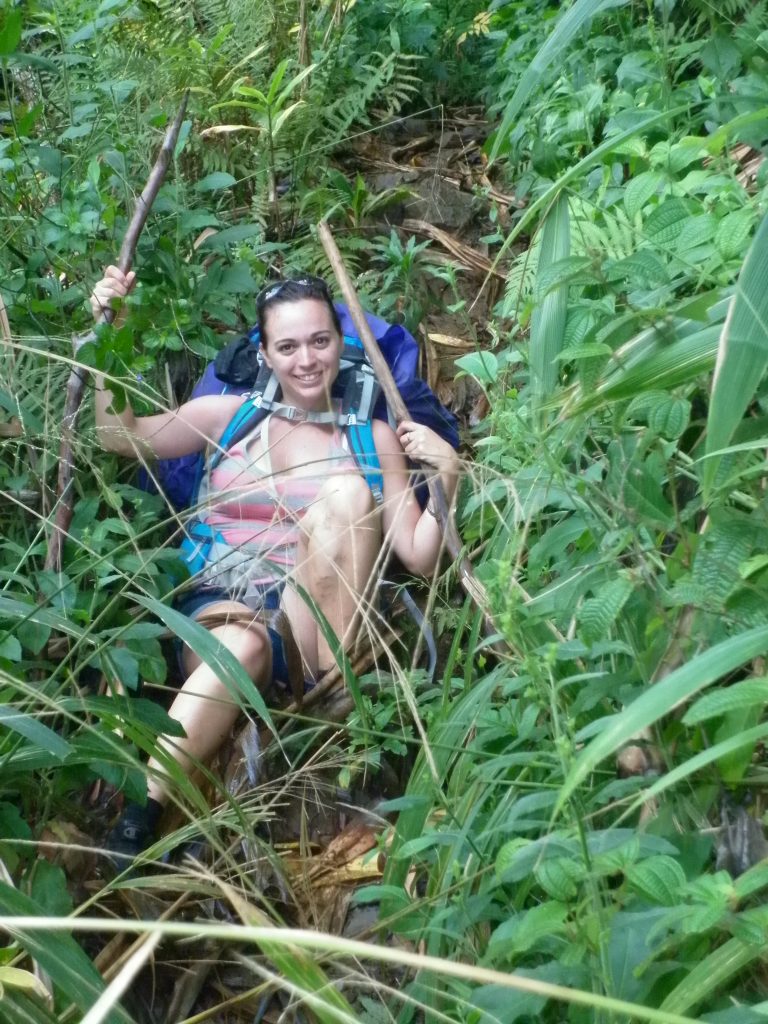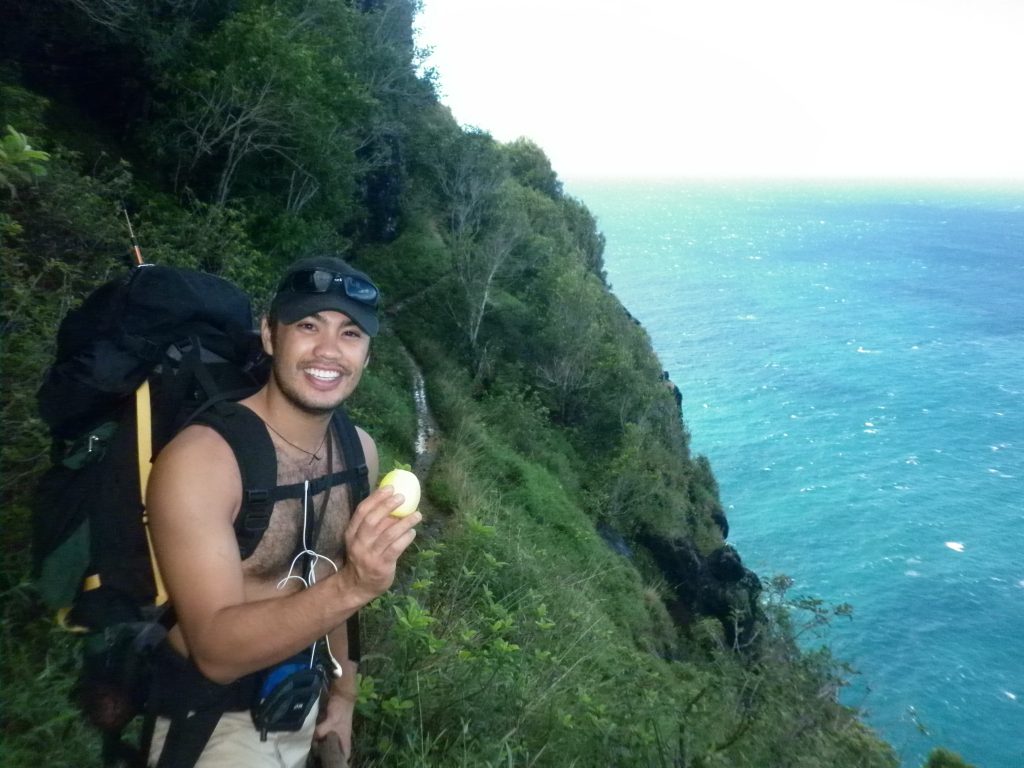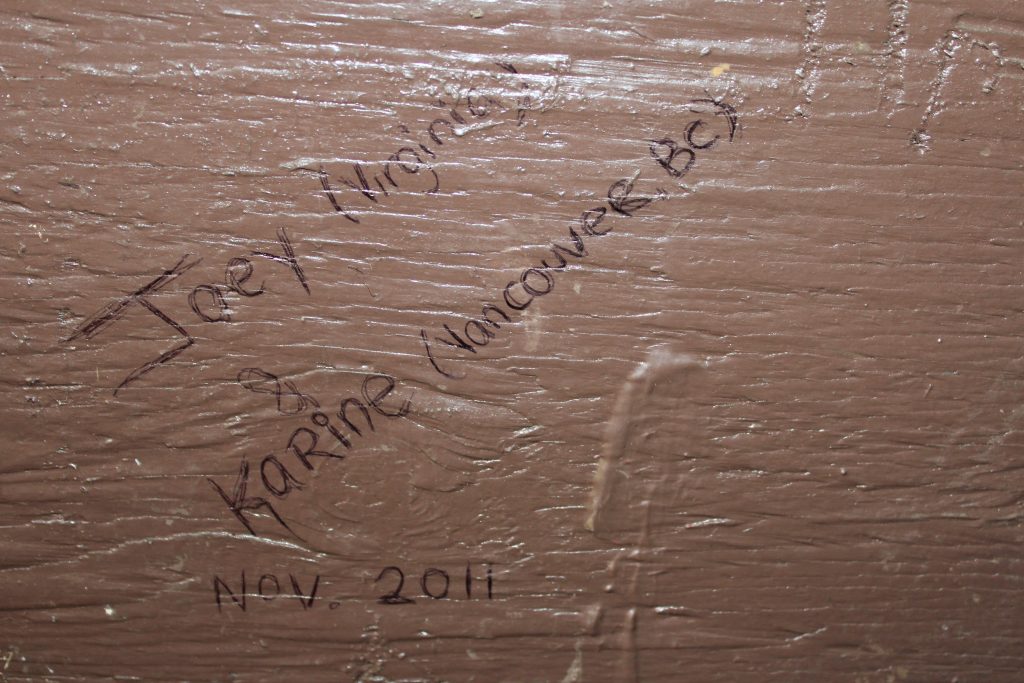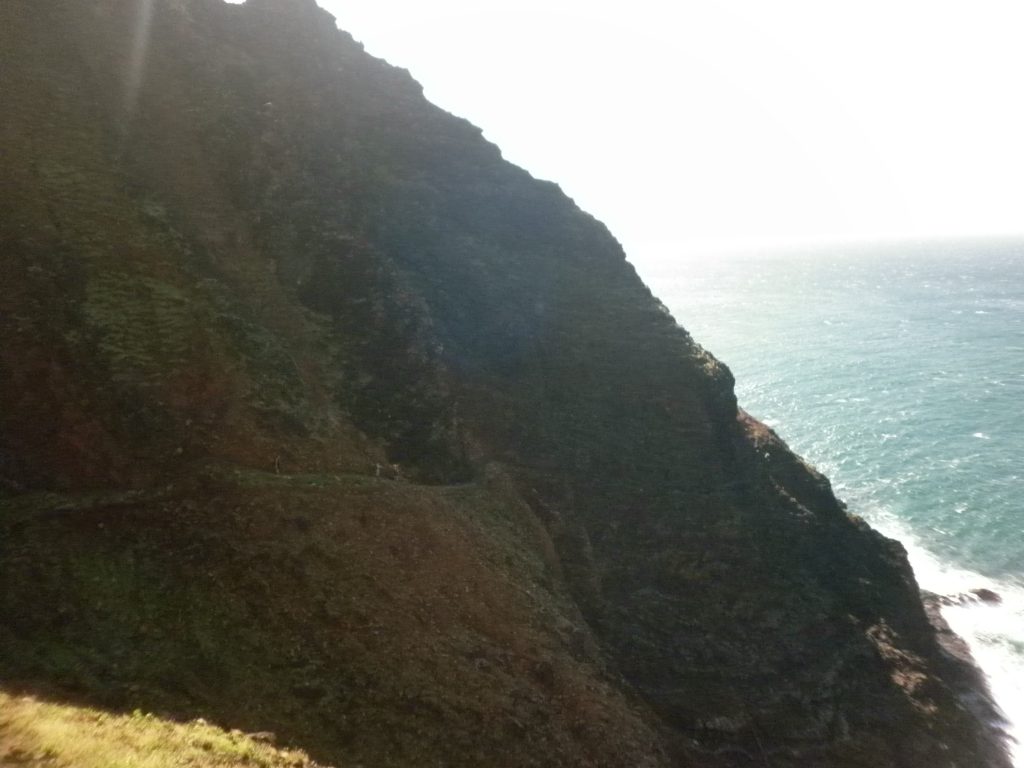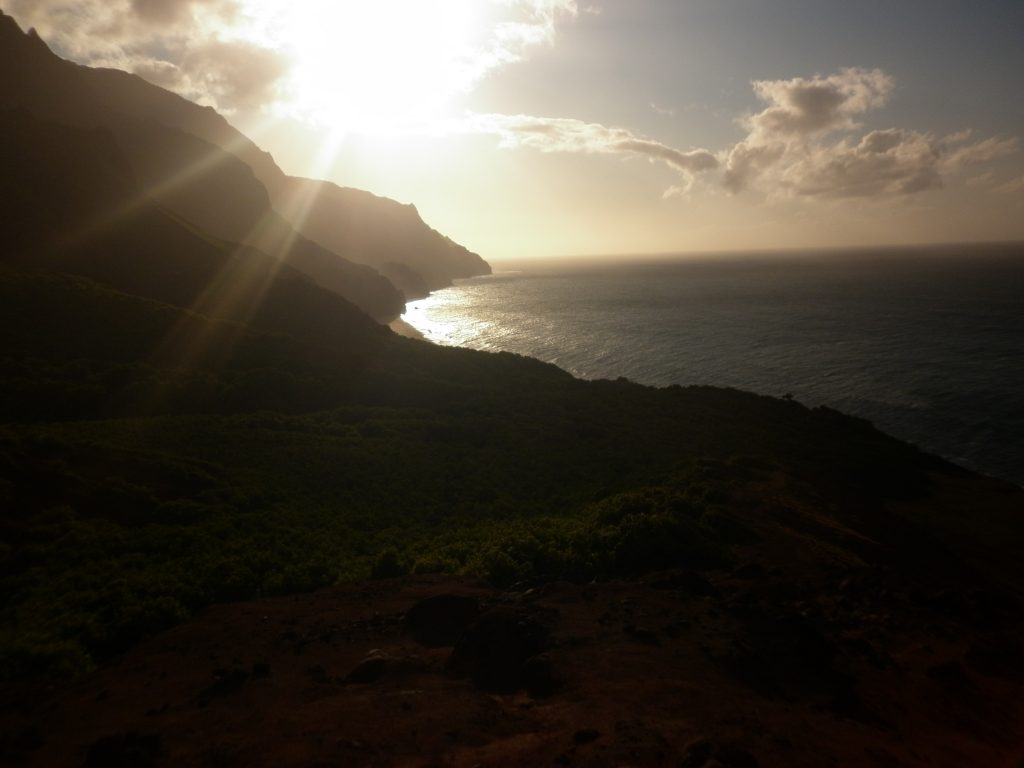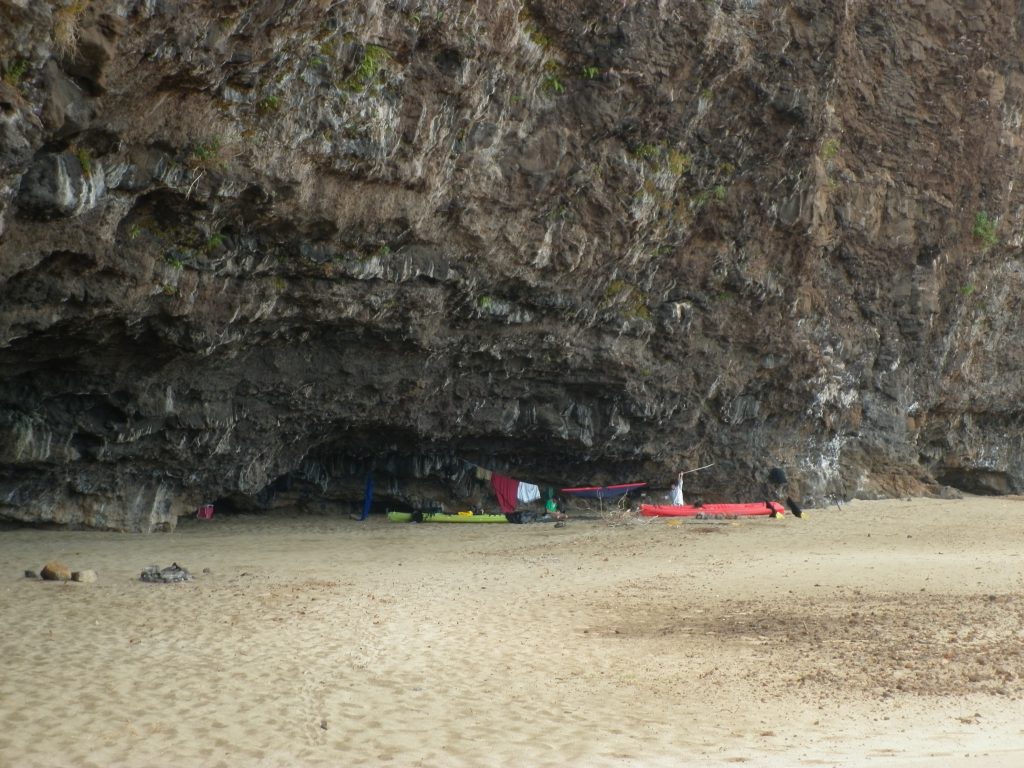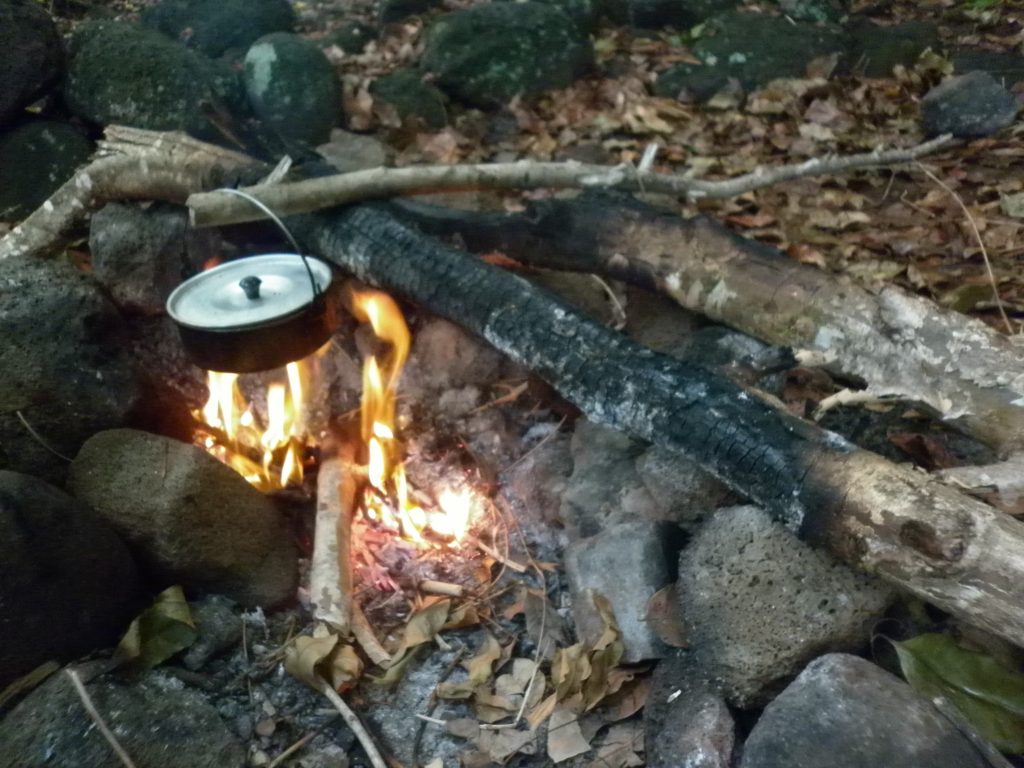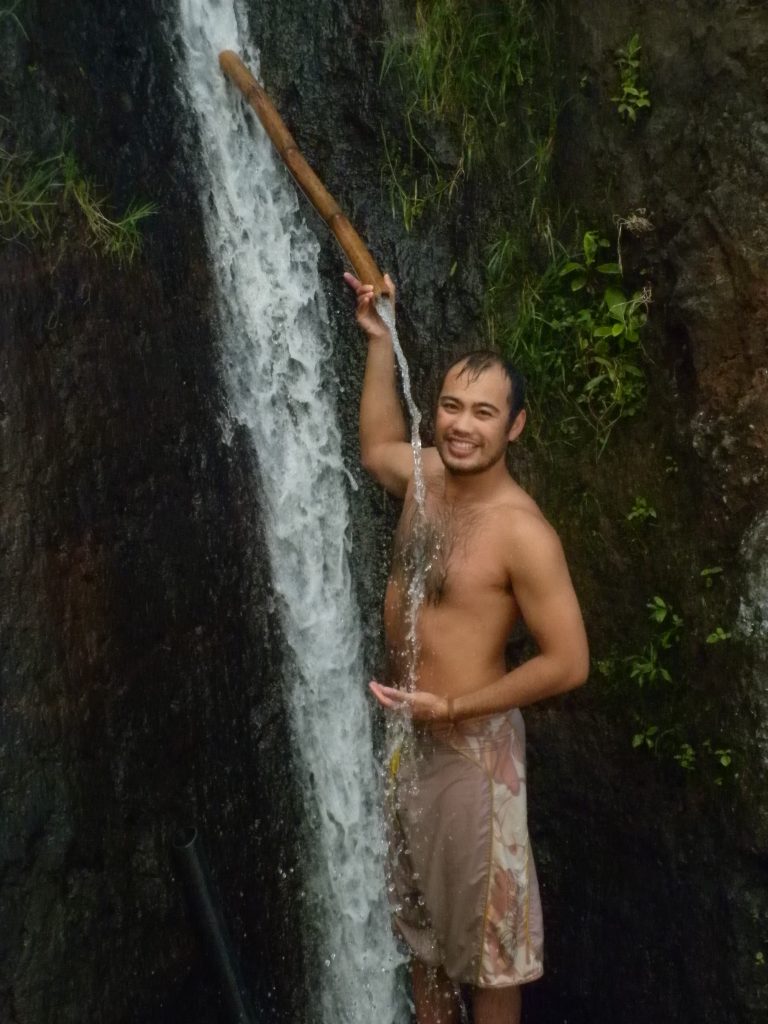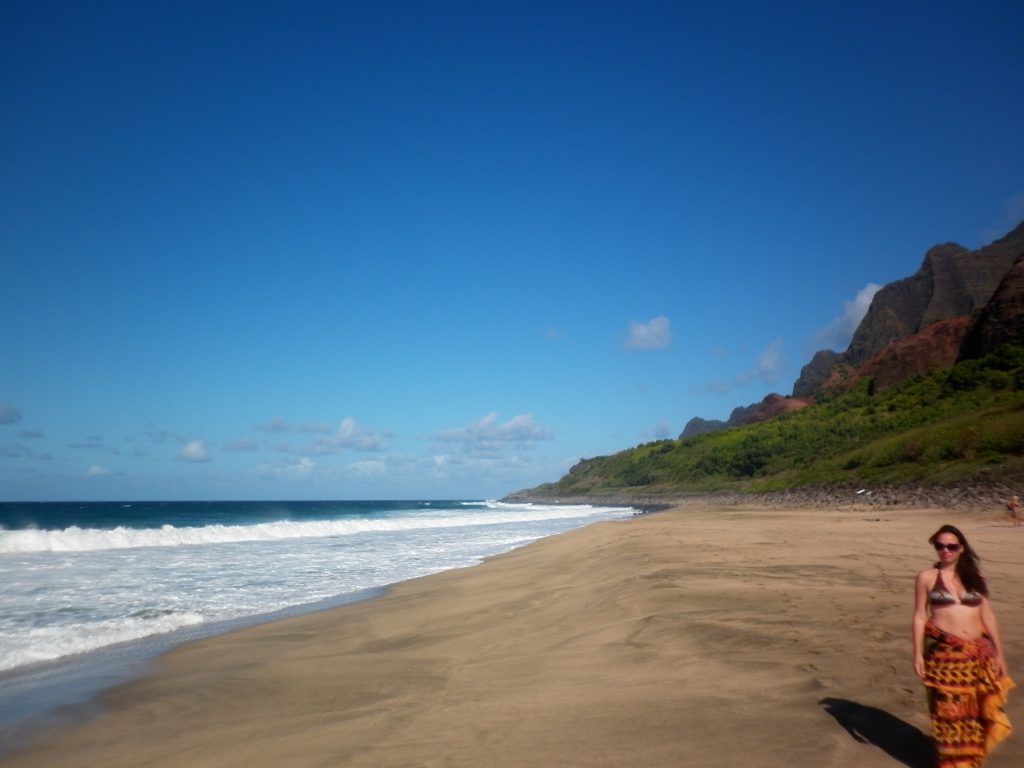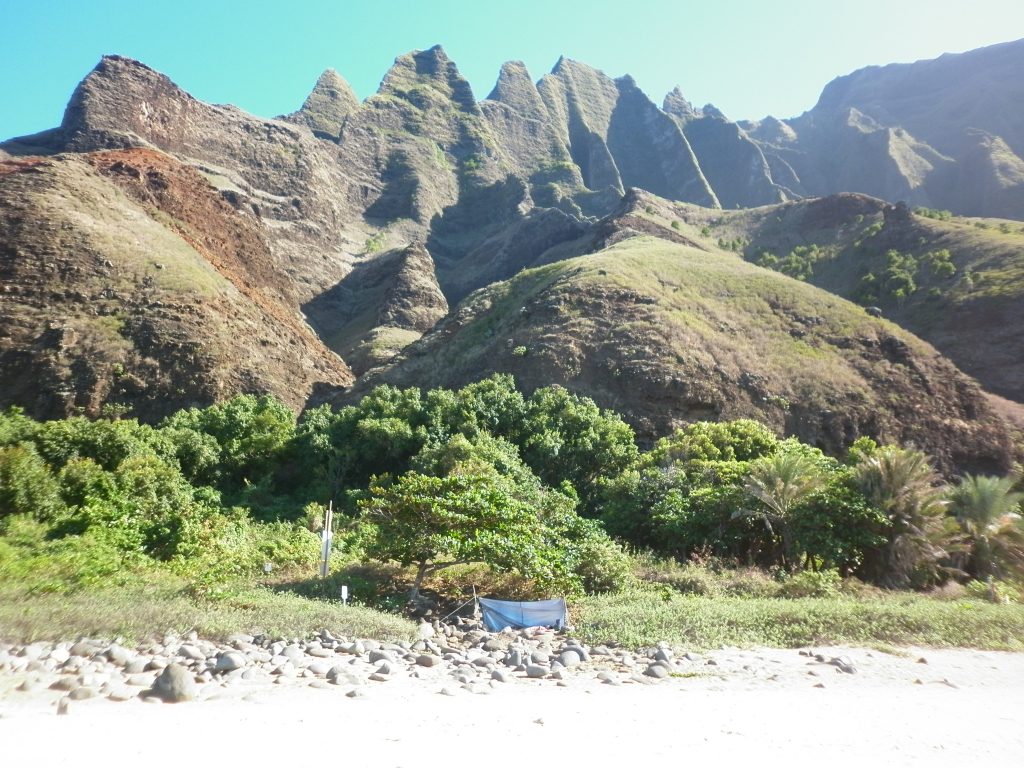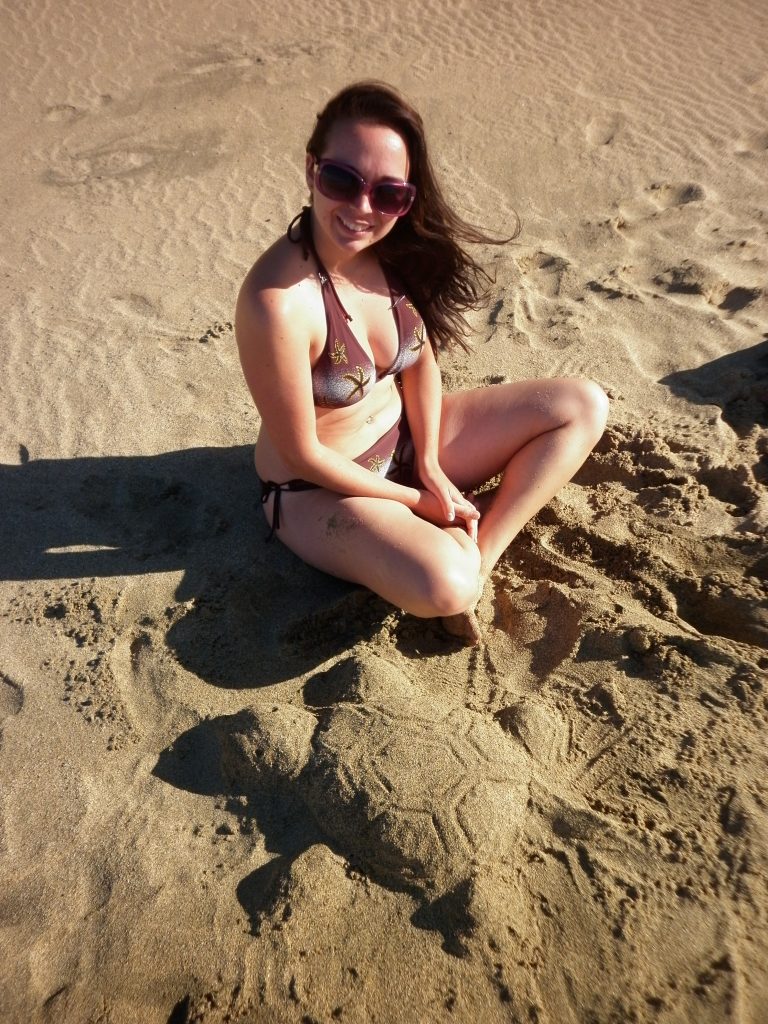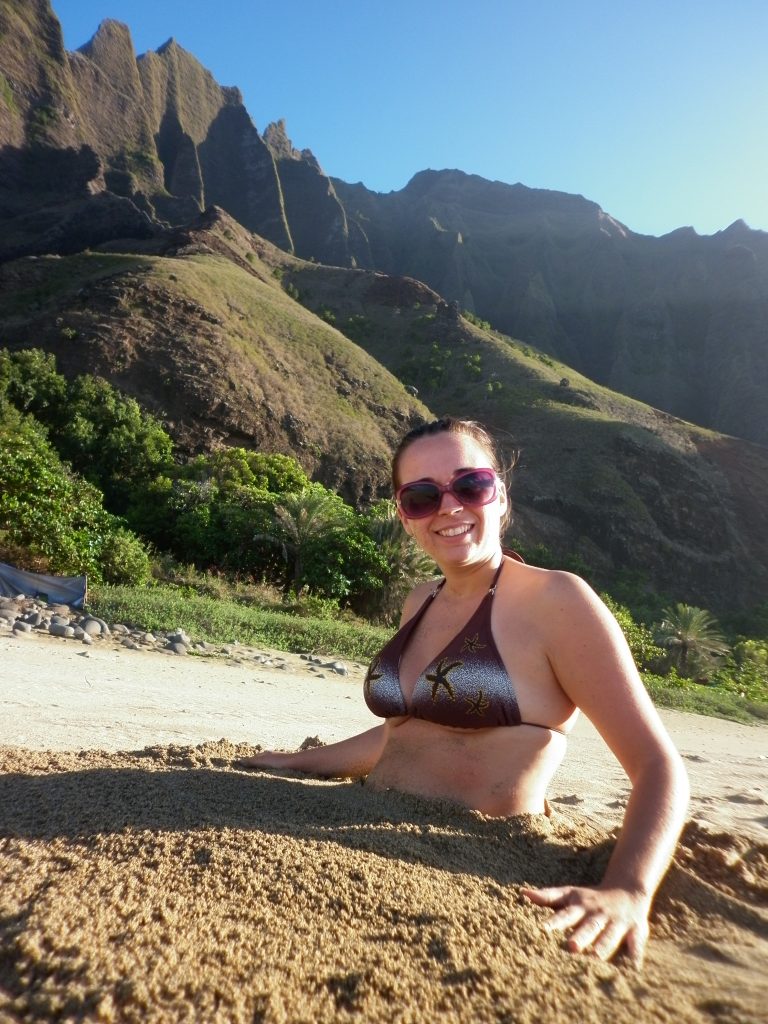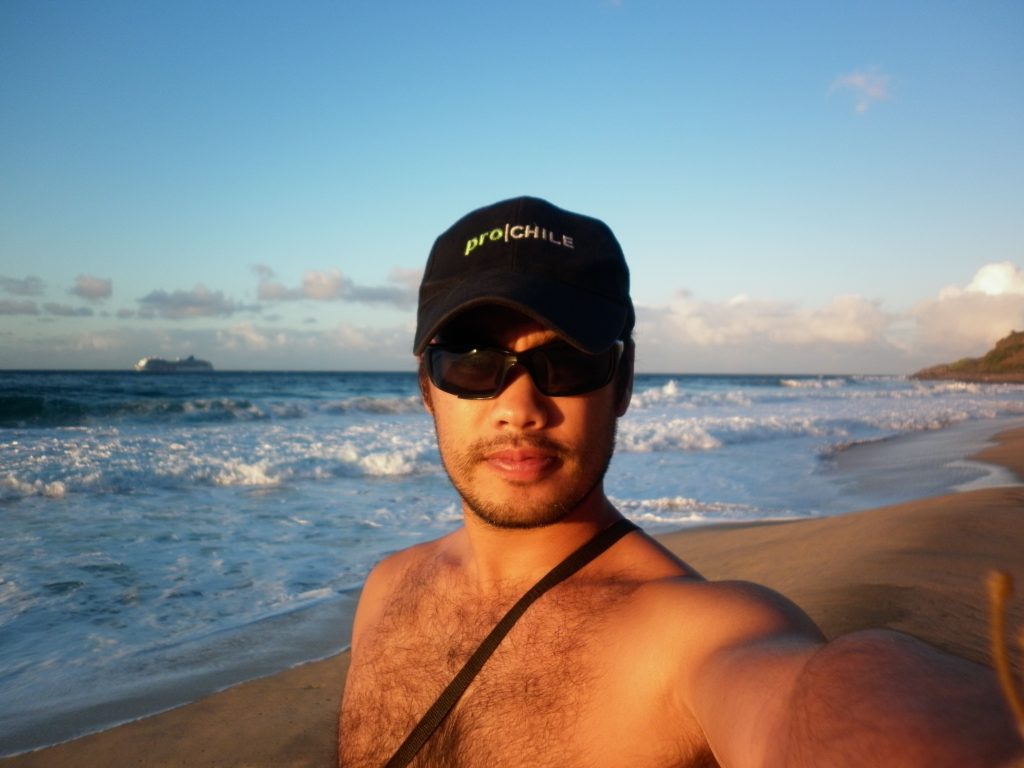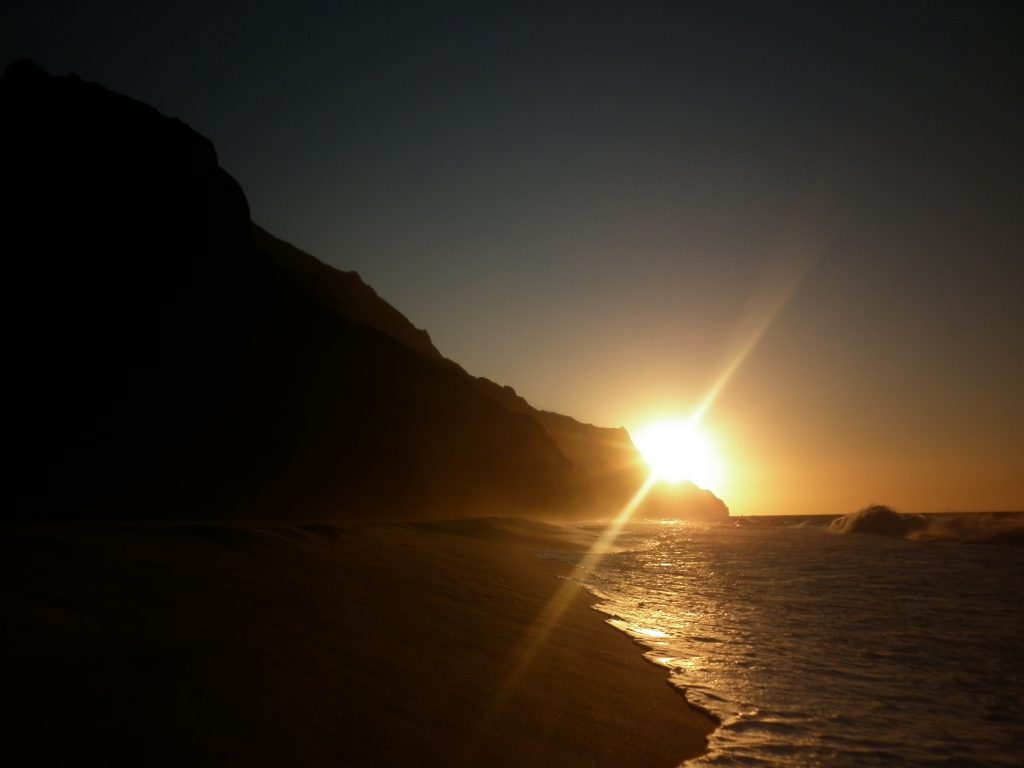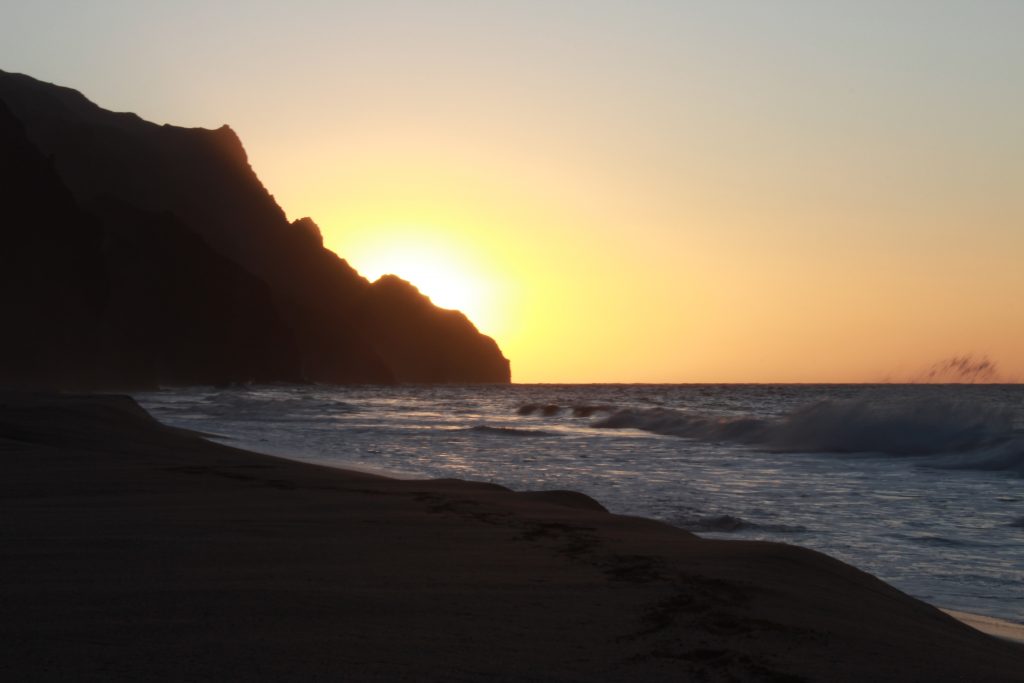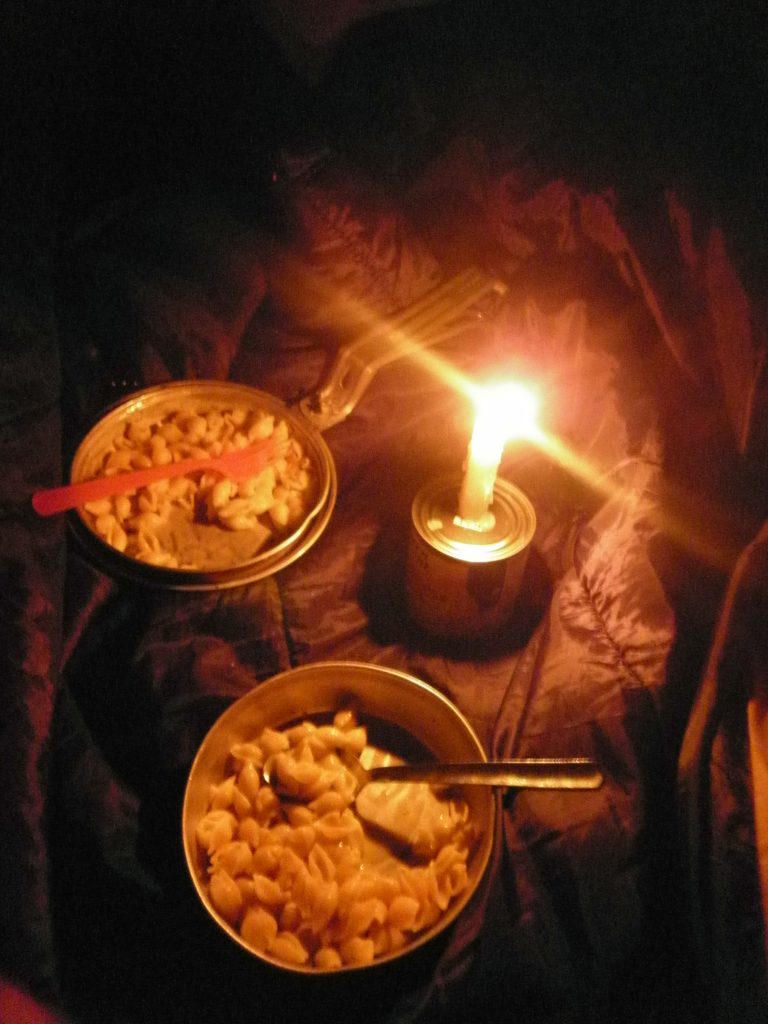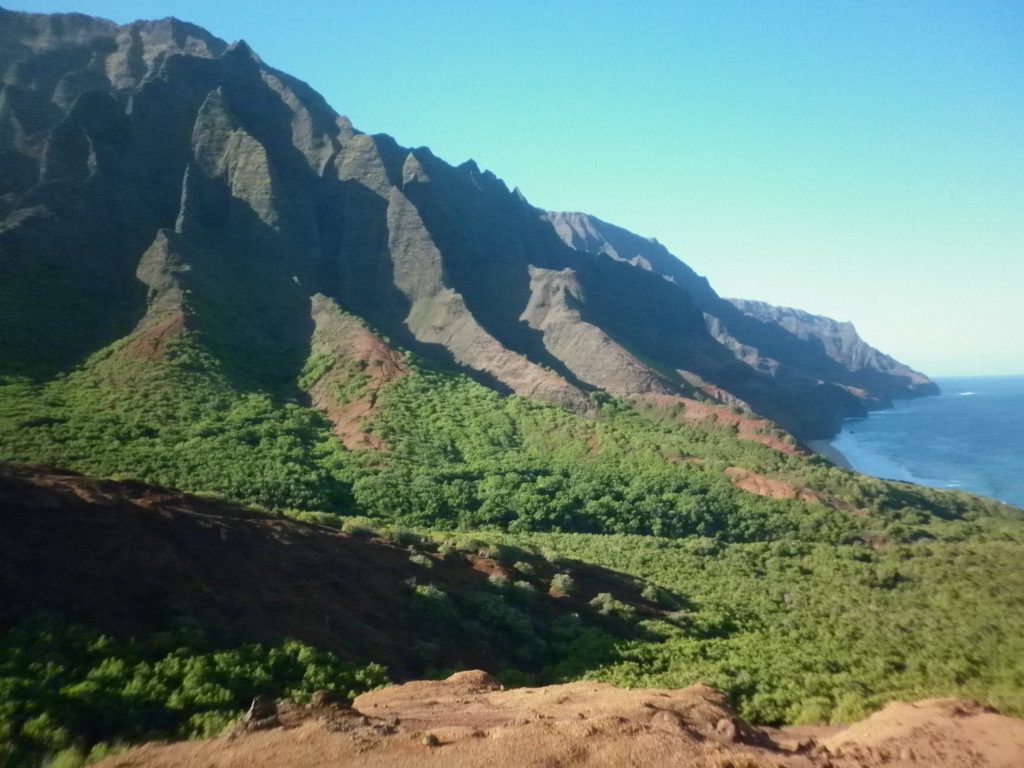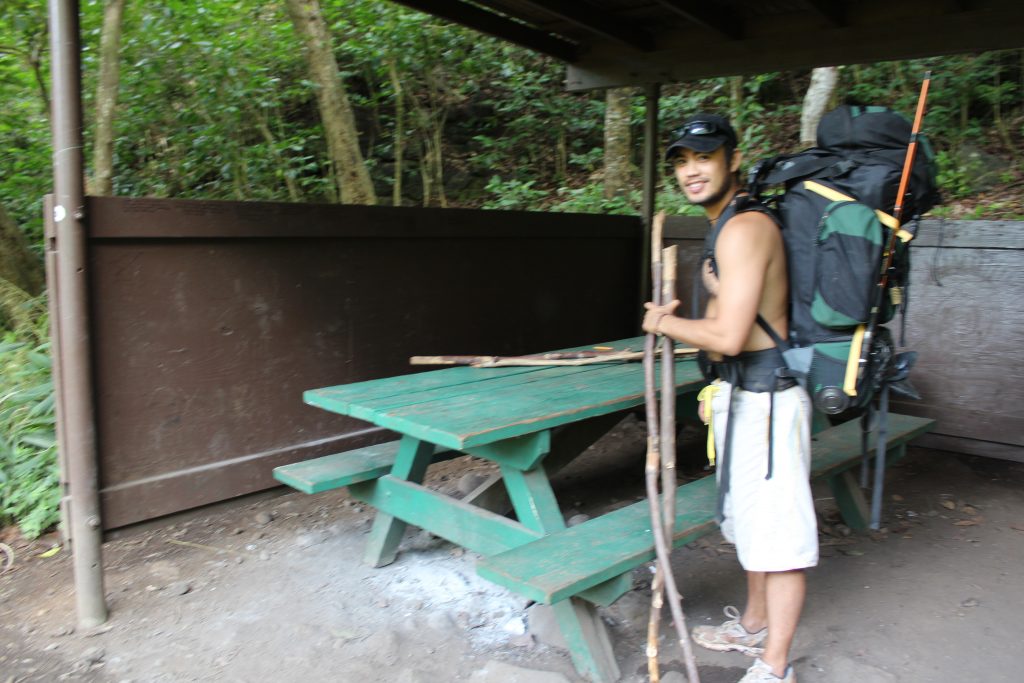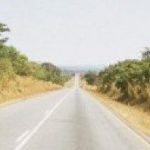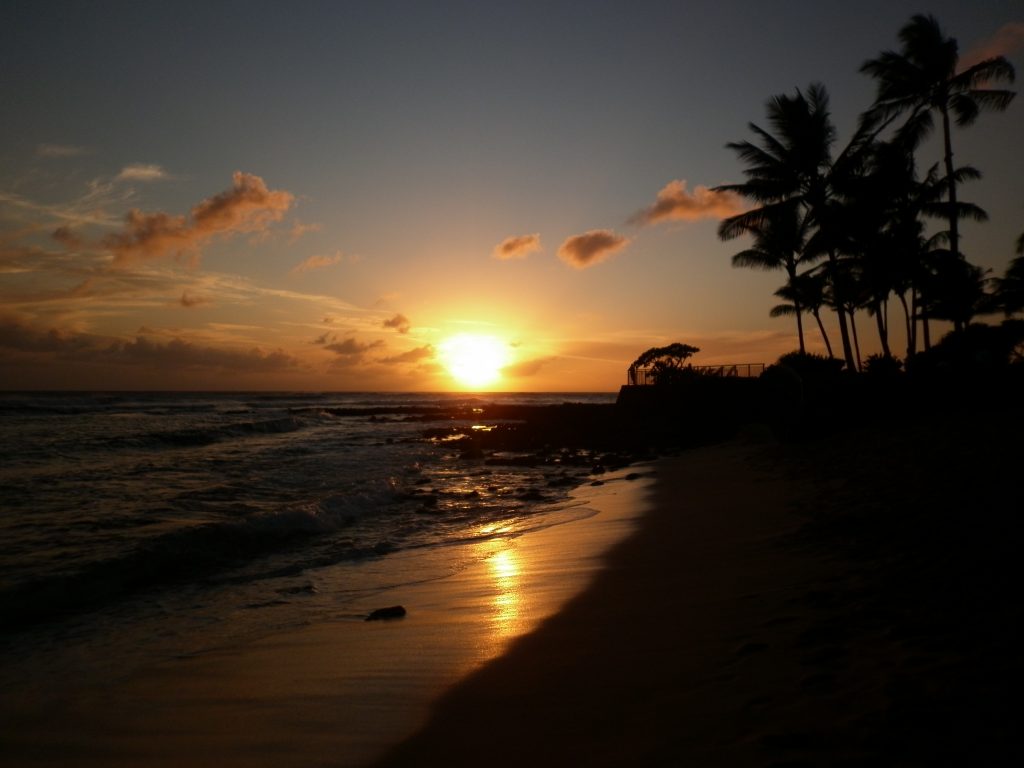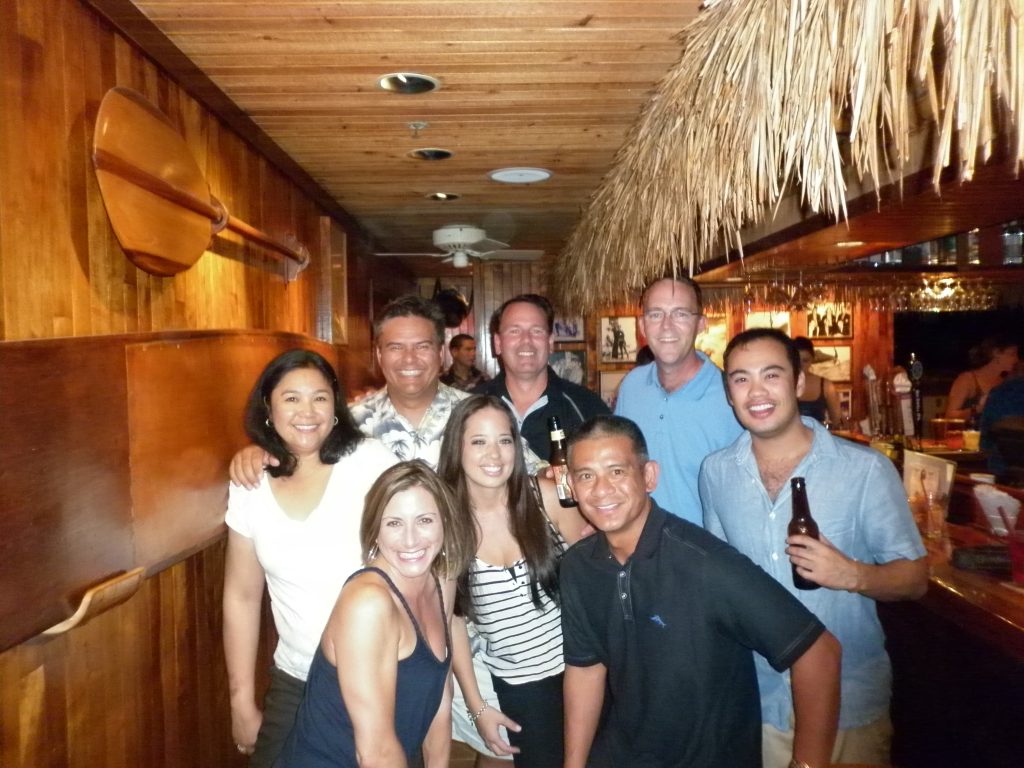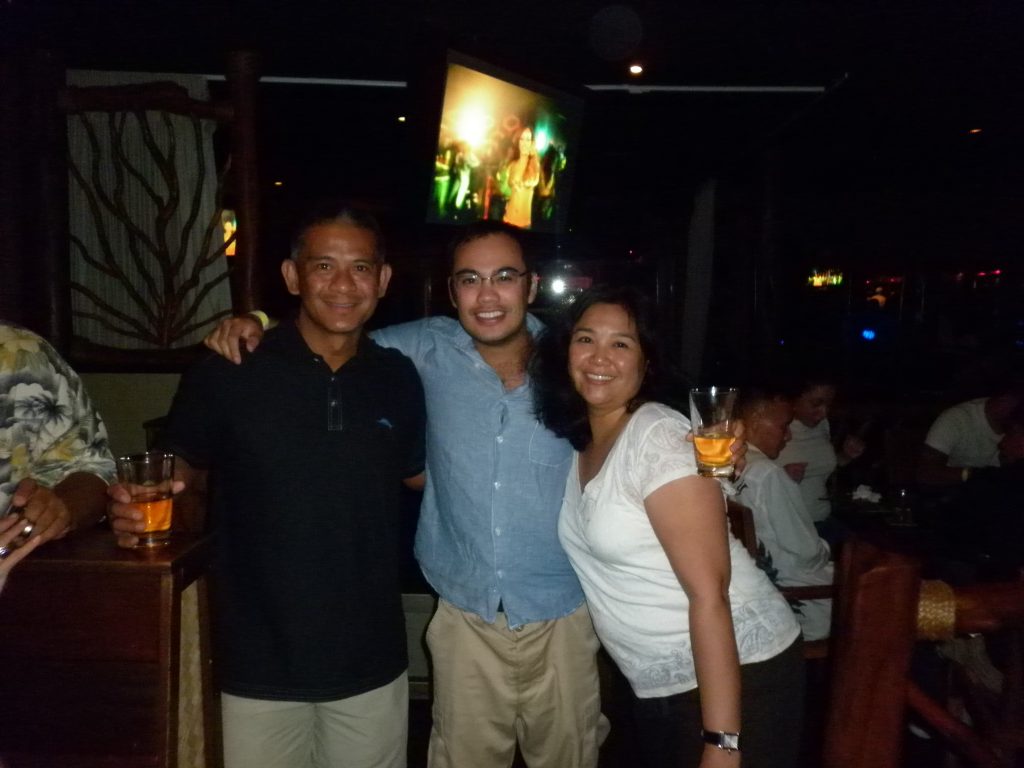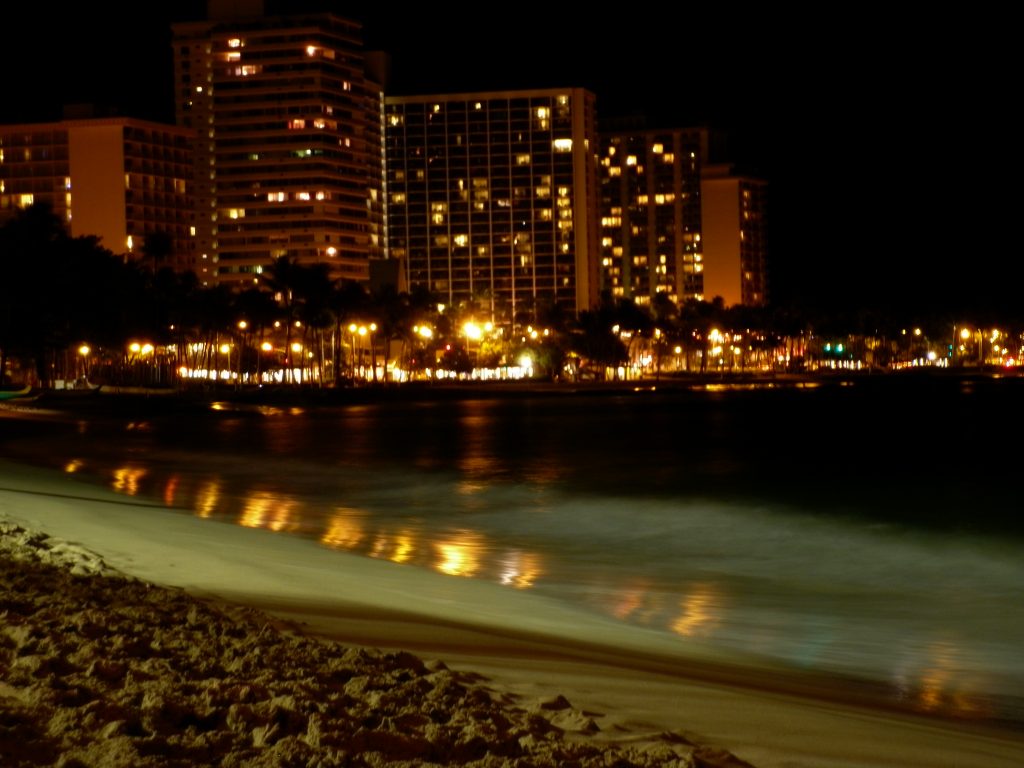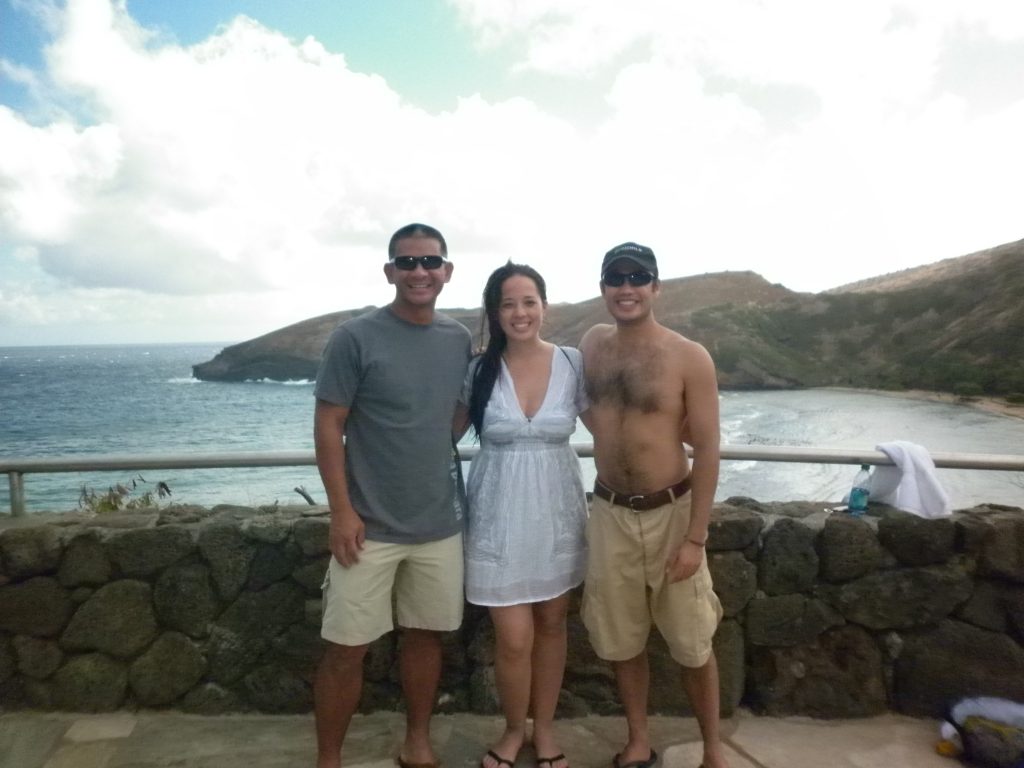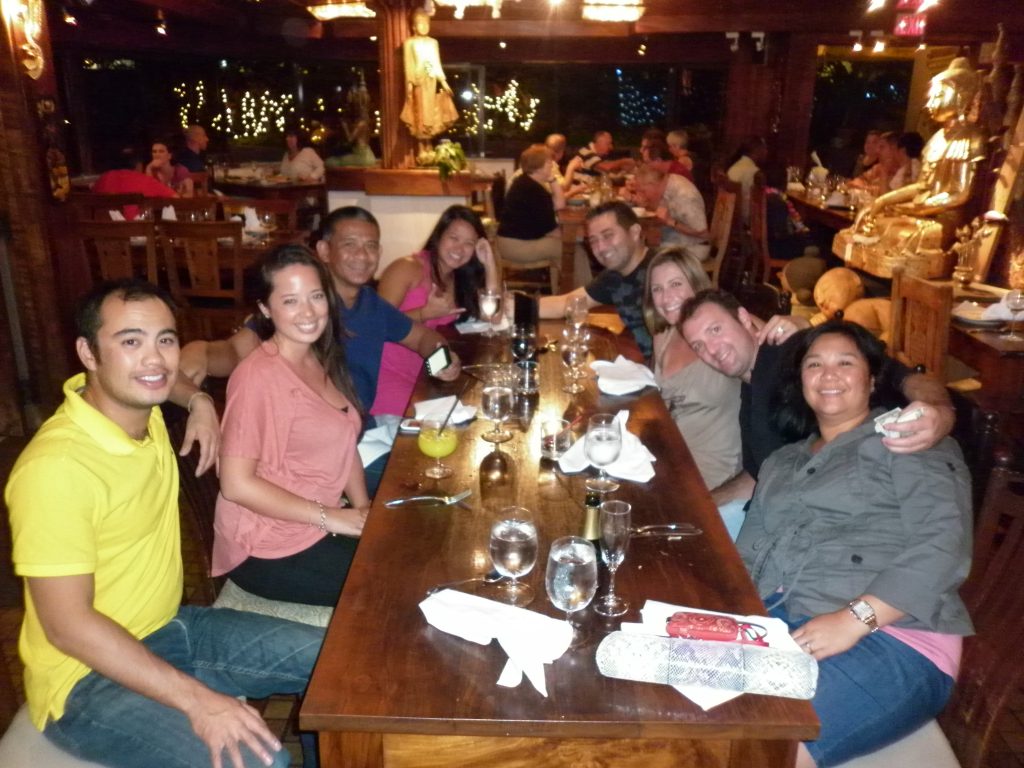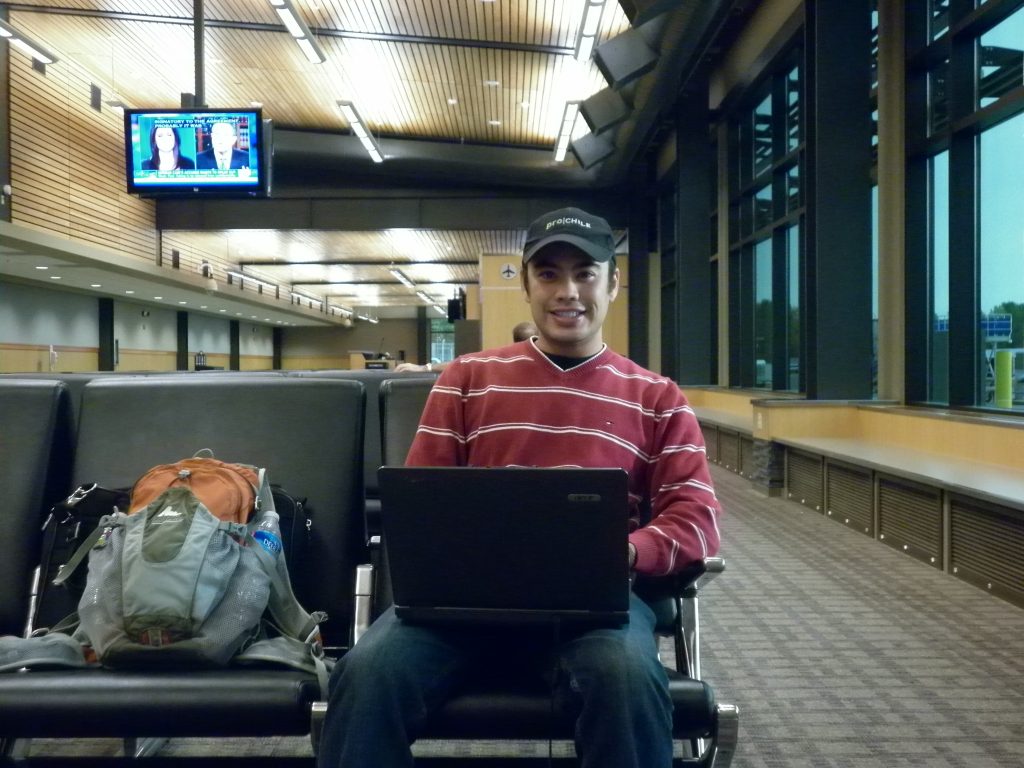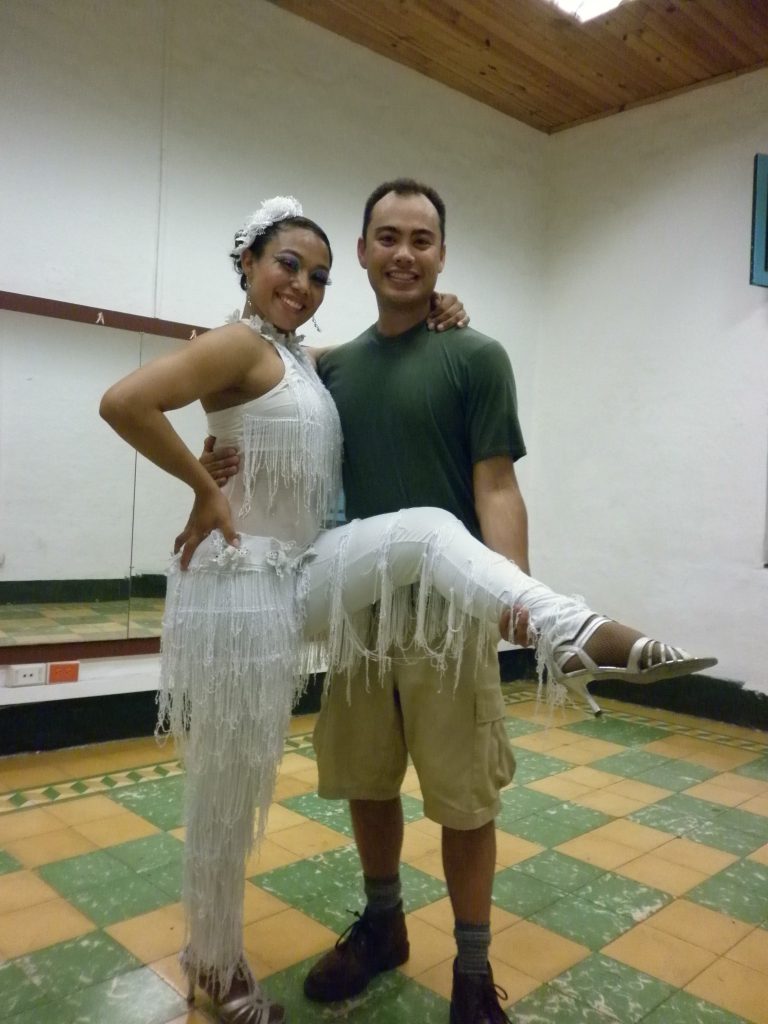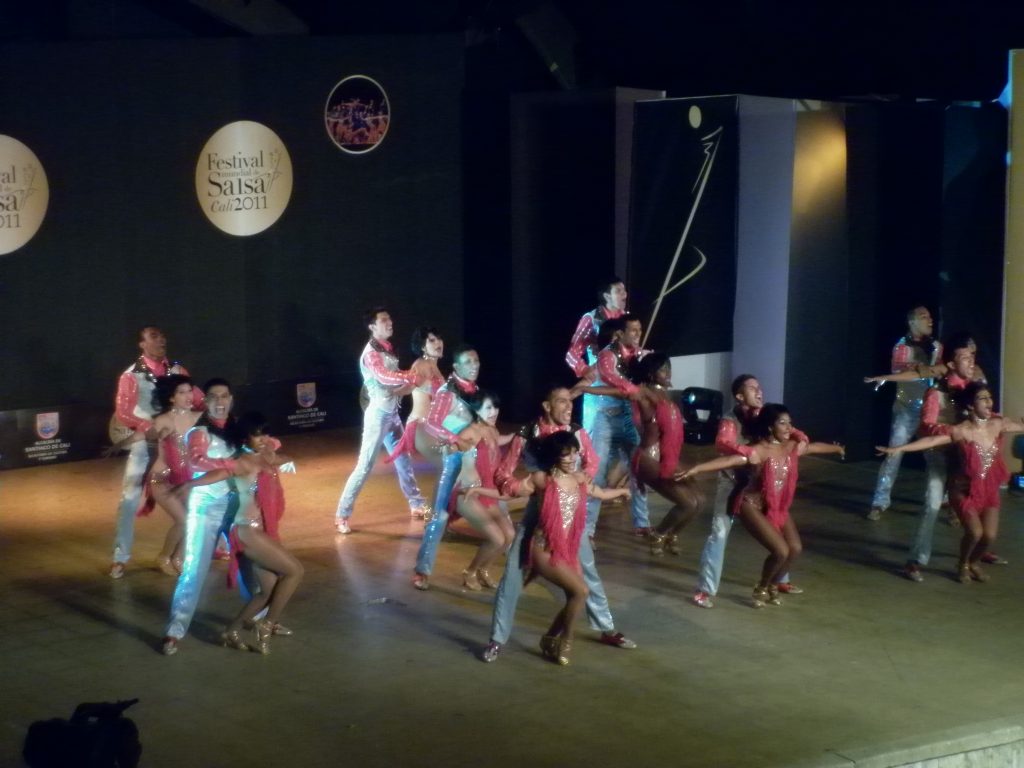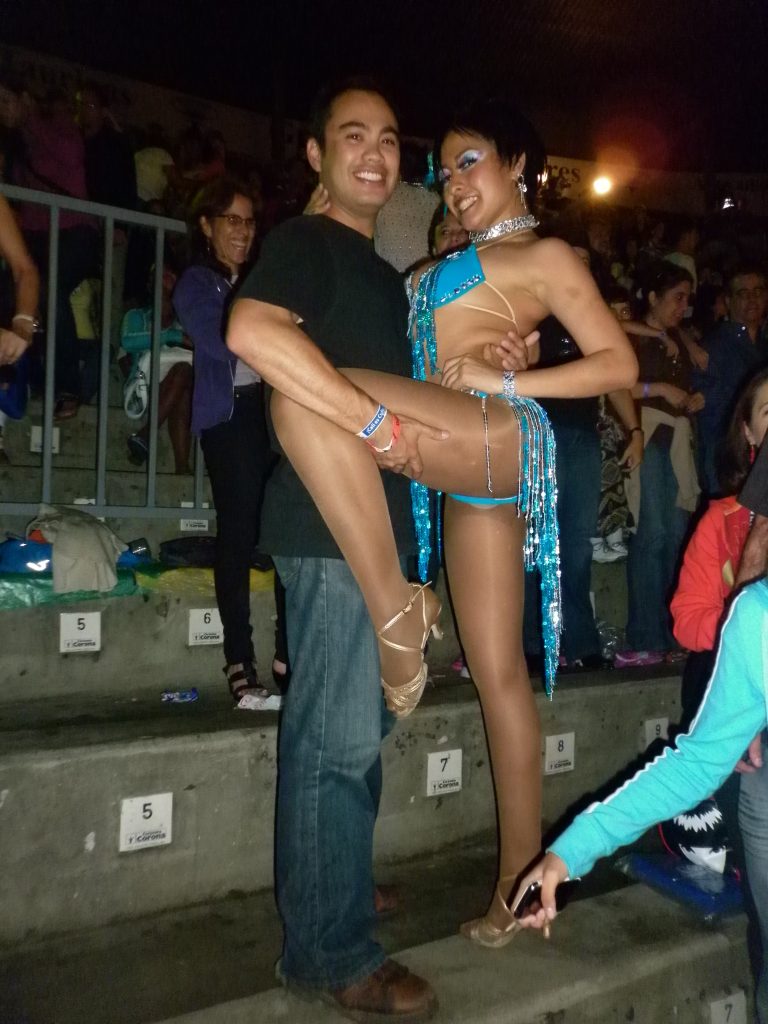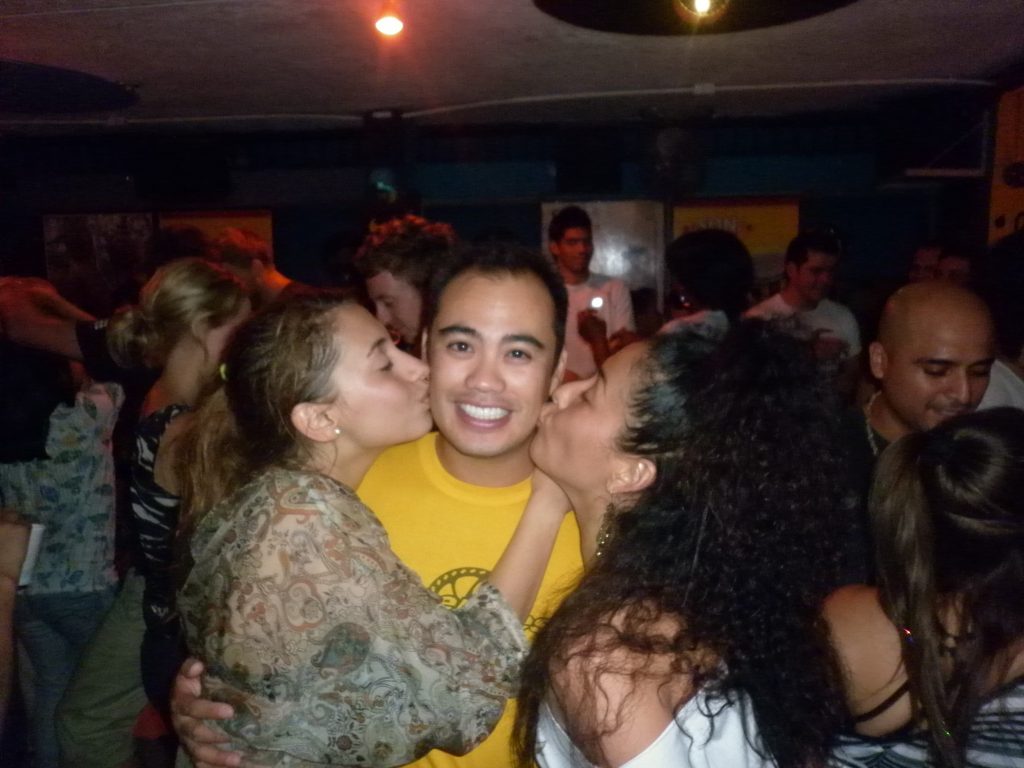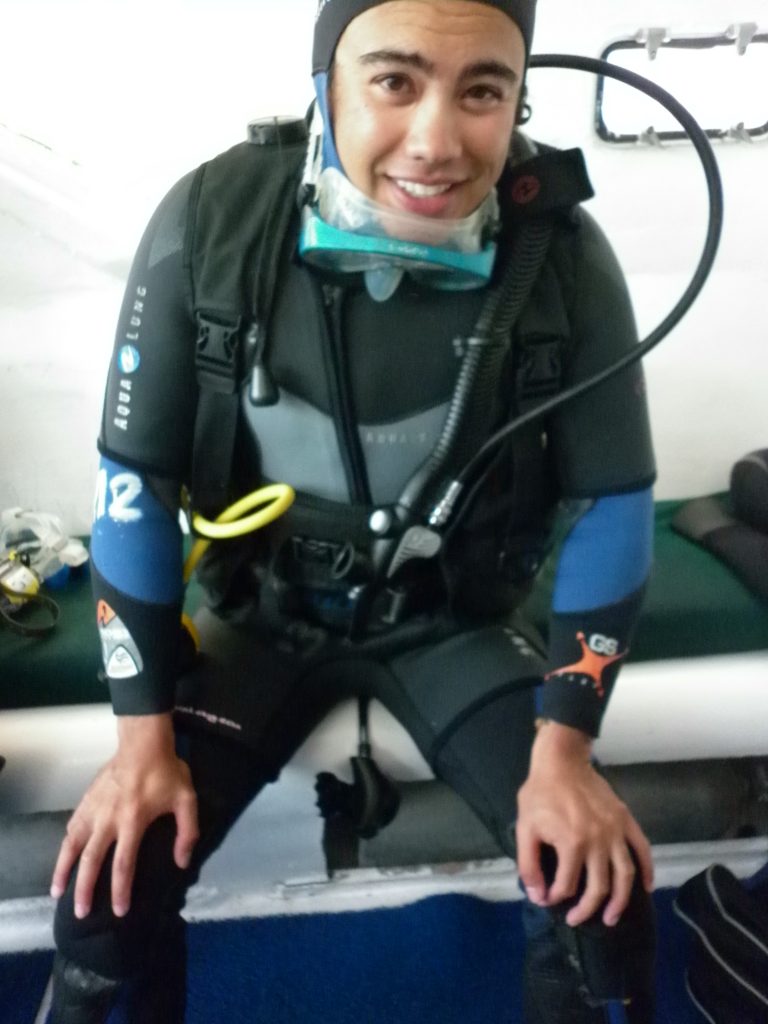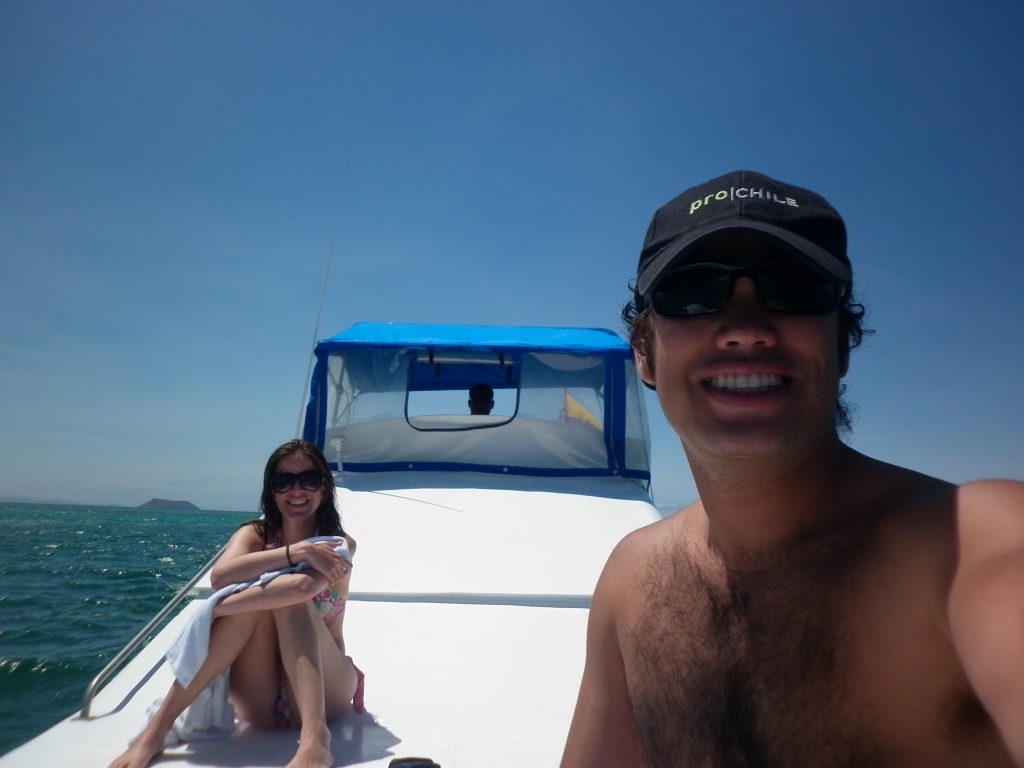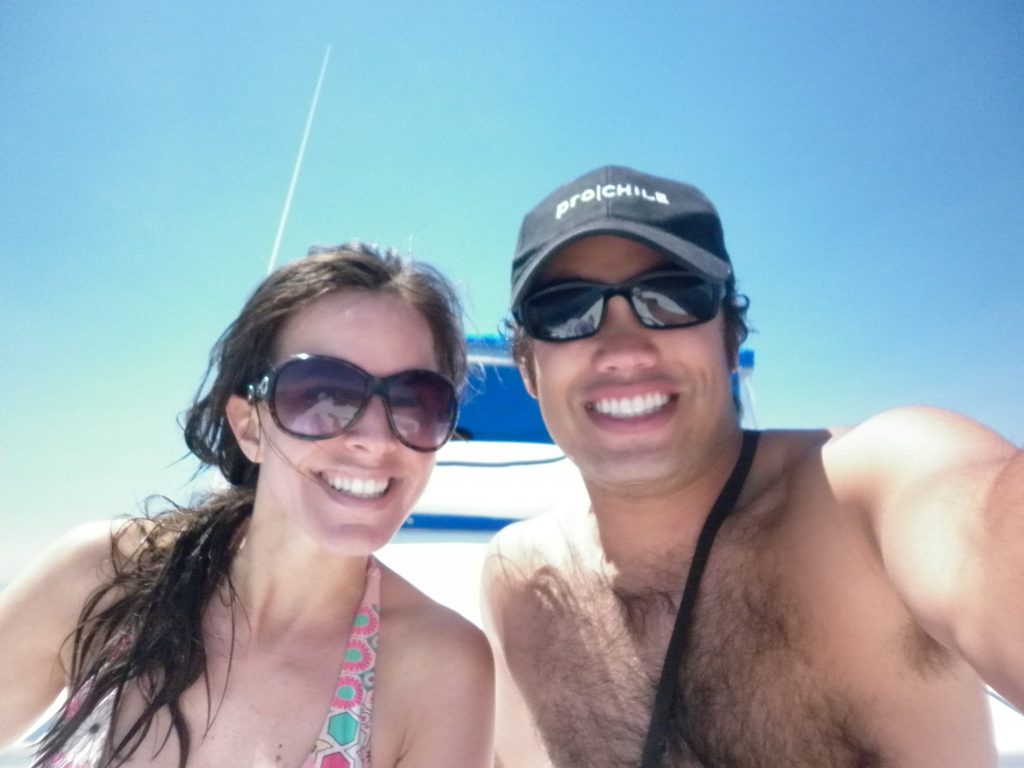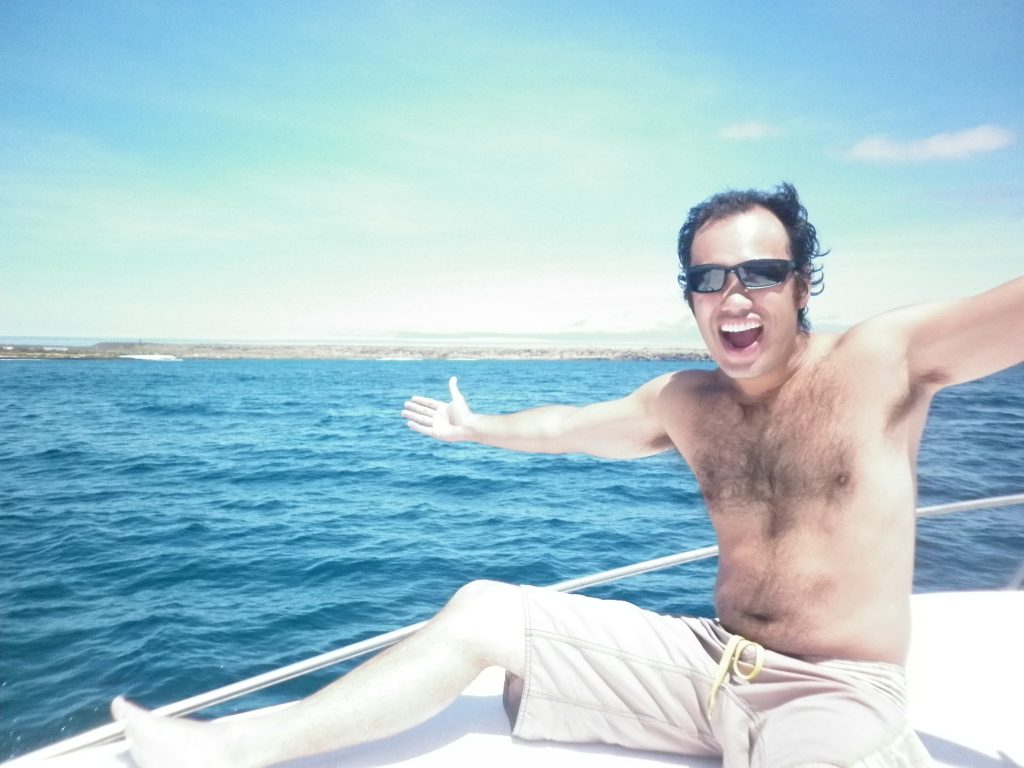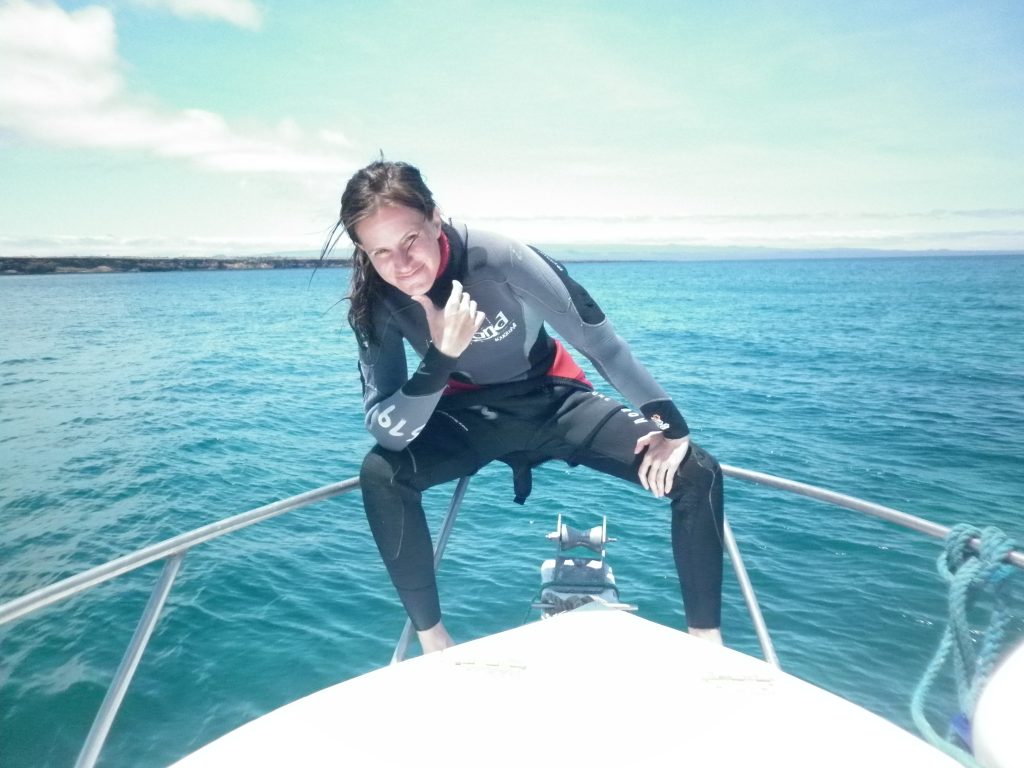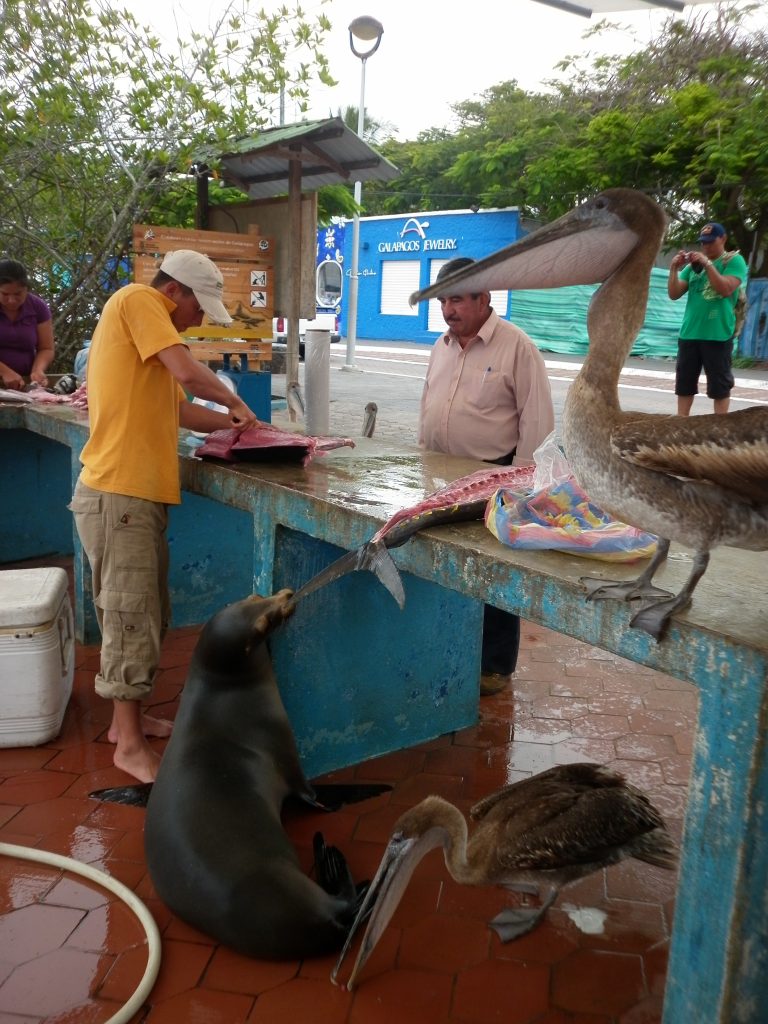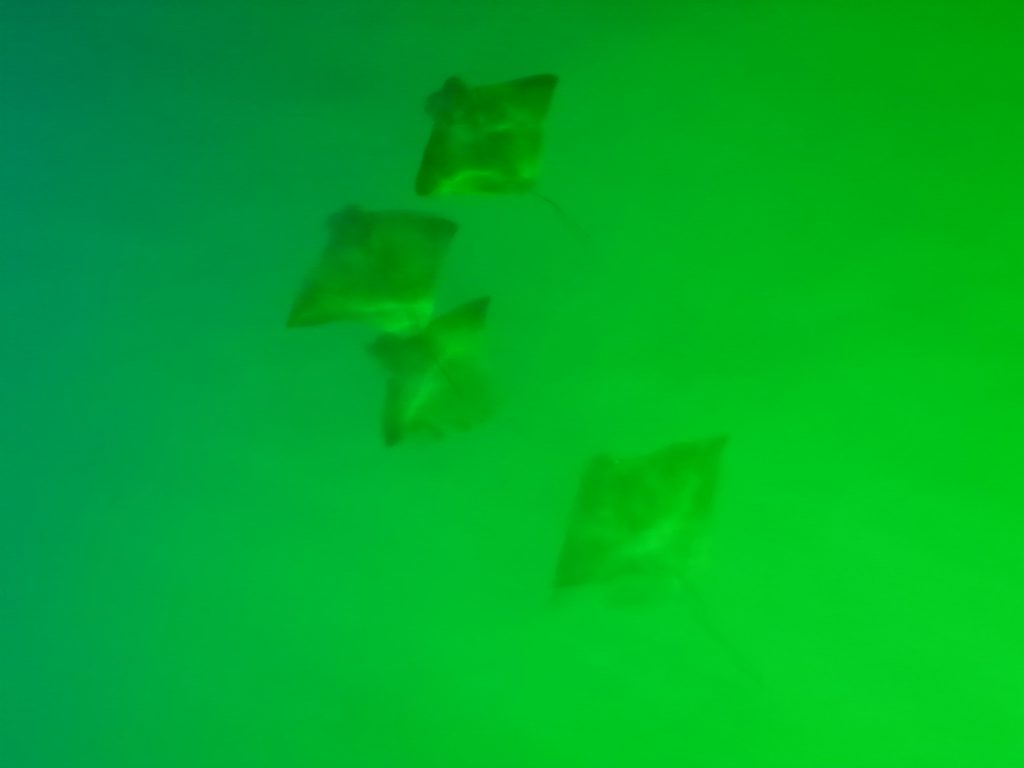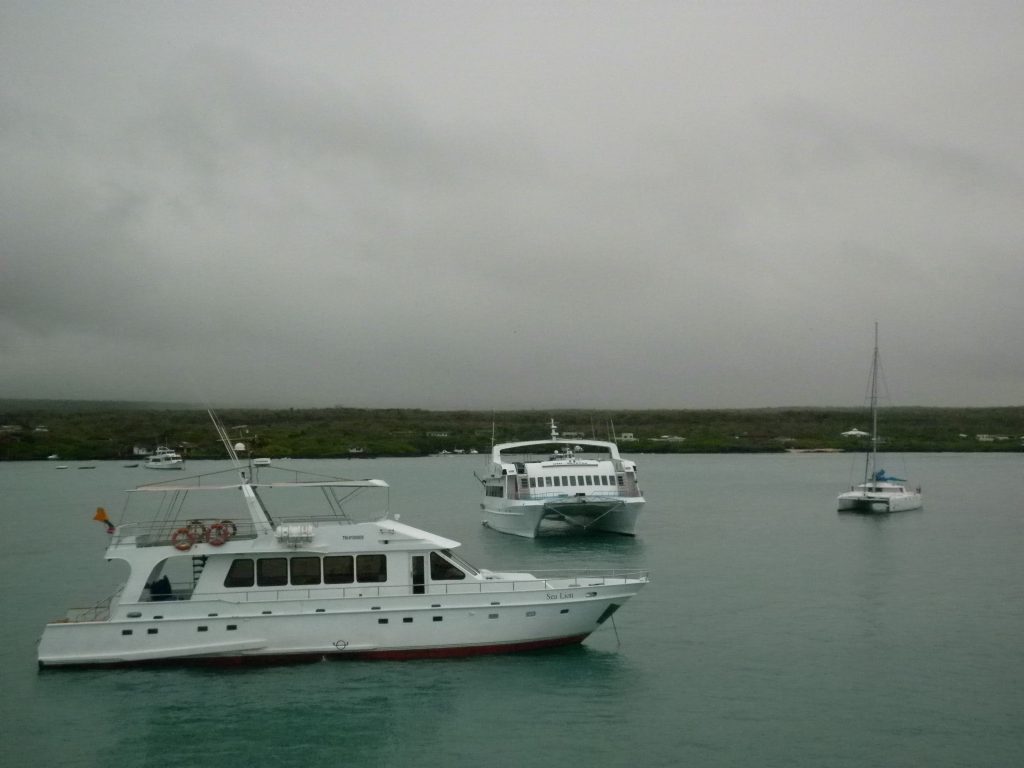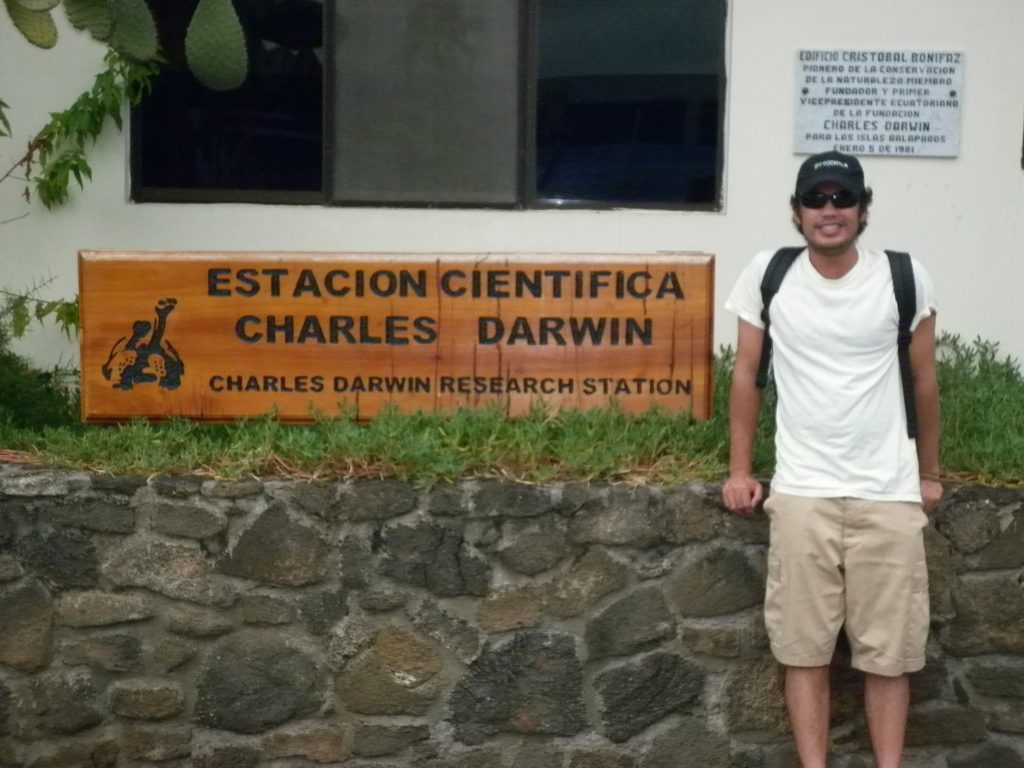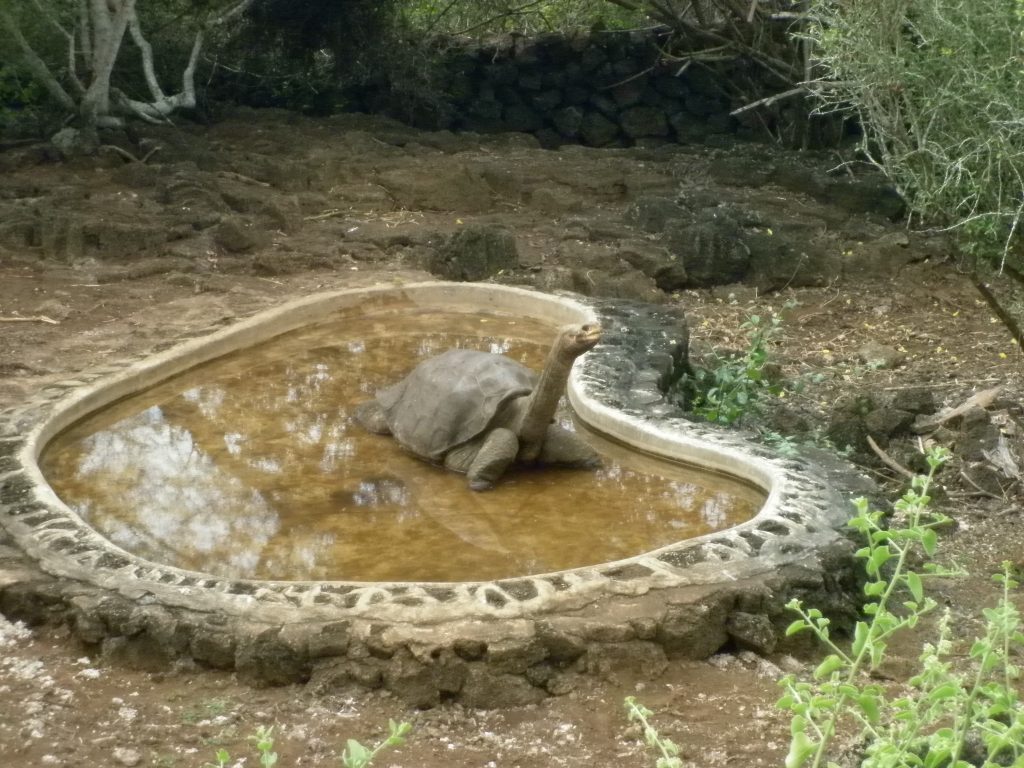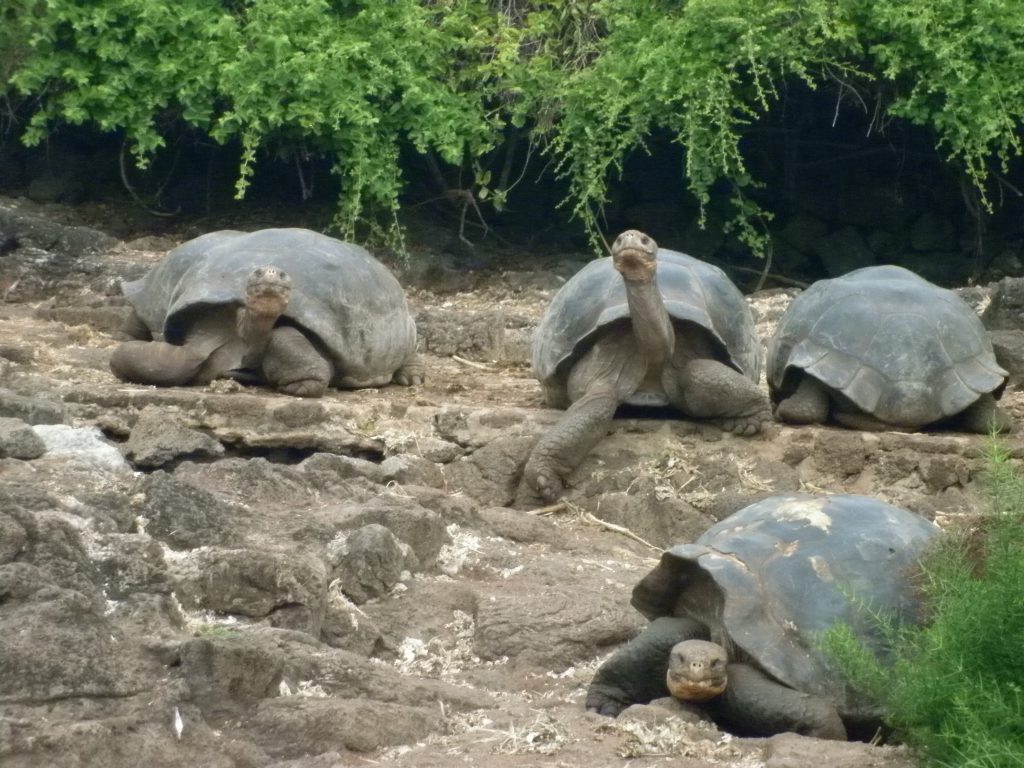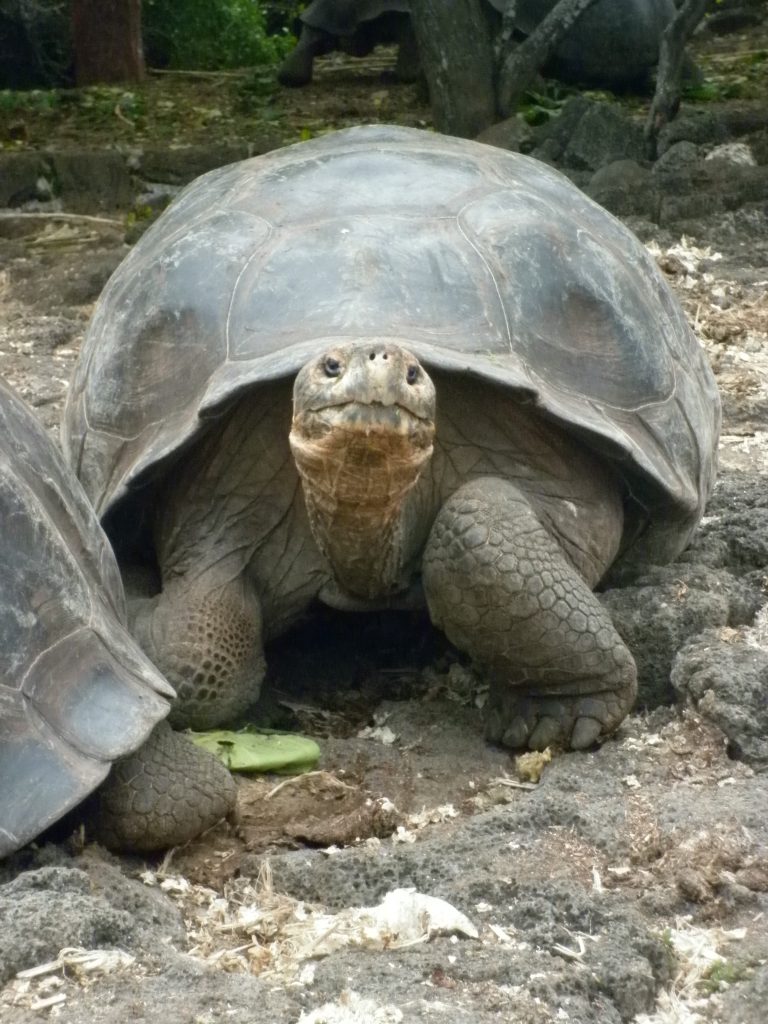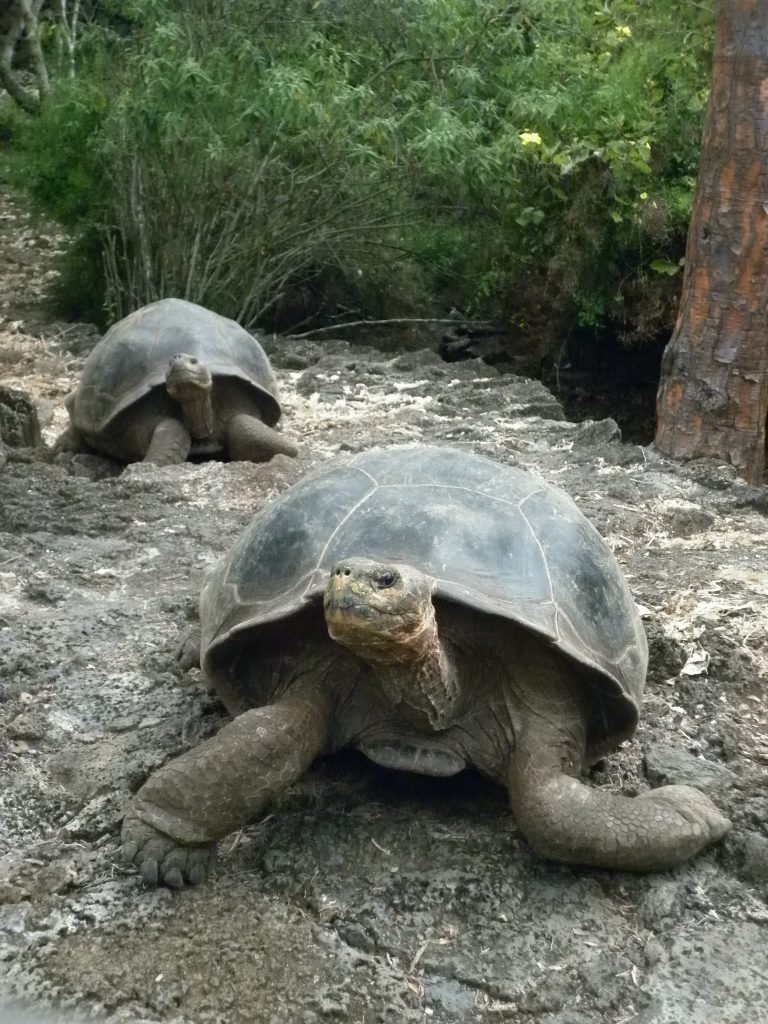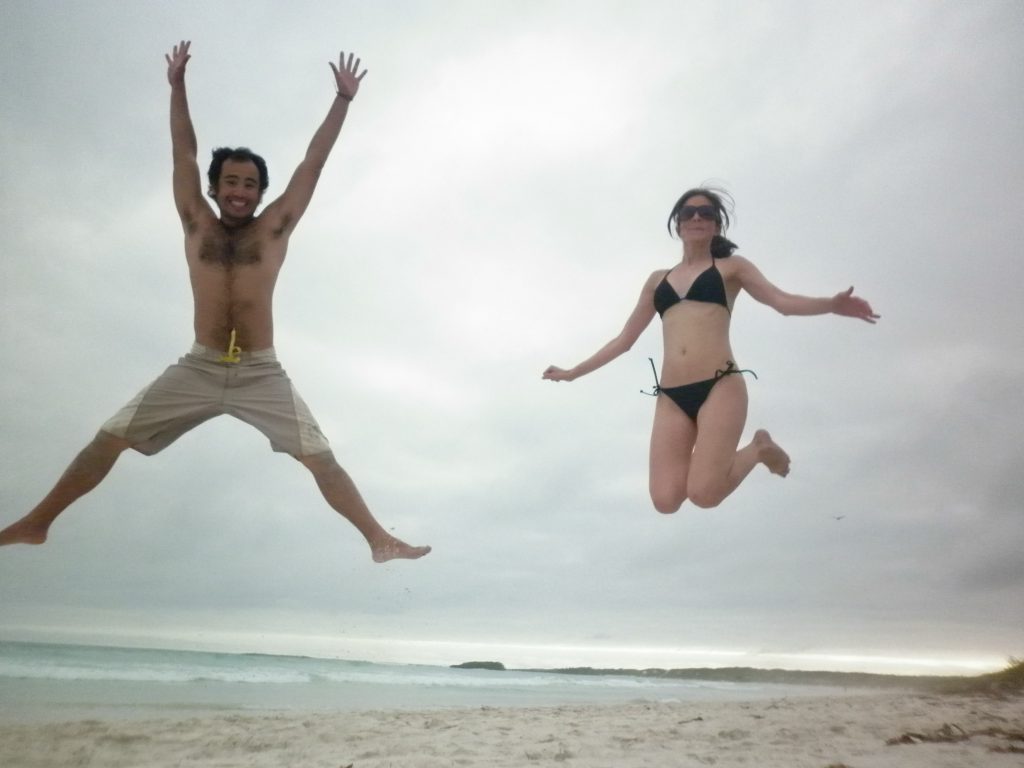View Larger Map
The day before I arrived in Kauai, my uncle’s friend, Jason, suggested that I hike the “Kalalau trail.” Upon my arrival in Kauai, I was delayed for a few days due to weather conditions. Eventually, I grew weary of hanging out at the hostel and decided to take my chances – rain or no rain.
November 8, 2011. The sea cave at Hanakapi’ai beach.
Just as I was about to head out on the morning of Nov. 8, 2011, I met another traveler named Karine, from Canada, who was about to go camping on her own up at Anini beach. We decided to join forces and do the Kalalau Trail together since it was also on her to-do list while on Kauai island.
We made our way north by bus to the end of the bus route at Hanalei beach. From there, we hitched a ride in a pick-up truck to Ke’e beach. By this time, it was already about 3 pm and we only had 2 miles to hike to our first campsite at Hanakapi’ai beach. The hike was very beautiful since the trail meandered high up in the cliffs overlooking the wide ocean blue below. I indulged in the cool, offshore seabreeze while taking in the spectacular view.

Let’s go!
The trail was muddy and had the consistency of peanut butter, or what Karine more accurately described as Nutella. She enjoyed walking through it much more than I did. I only wore running shoes and did my best to keep them dry.
Several days of rain had delayed the hike because I was warned of high water levels at the Hanakapi’ai river which would have made crossing it impossible. When we finally made it to the river, it was an easy crossing through knee-high water.
As soon as we arrived at the beach, we took off our heavy backpacks and wet shoes to walk in the sand and explore. We discovered a sea cave off towards the left-hand side of the beach. The roof was like that of a wide, spacious cathedral. From within, we could watch the waves crash against large rocks in front of the cave. It was like a scene out of the movie Pirates of the Caribbean.

Hanakaipi’ai beach.

Karine loved this cave.
The next order of business was to find a suitable location to set up camp. It would’ve been nice to sleep right on the beach, or even inside the cave, but I was very wary of the inundating effects of the incoming tide or a flash flood coming from the river behind us. The last thing I wanted was to wake up in the dark and covered in water. The other option was to sleep in the designate campground back in the jungle. We scouted it out. The air felt muggy and stifling, and there were mosquitoes and guava flies everywhere. We opted instead to camp just inside the treeline which afforded us an ocean breeze to keep bugs at bay. On high, we would be safe from the incoming tide and the danger of a flash flood.
Karine did a excellent job setting up the tent and tarp, which kept us dry when it rained later that night. Meanwhile, I walked to the sea cave to start preparing the Spanish rice and Portuguese sausage that we had brought with us for dinner. The cave offered shelter from the heavy wind coming from the ocean and it was very comfortable. I lit candles and placed them in the sand around us inside the cave. It glowed a lovely, orange light. Between the sound of the waves crashing just outside the cave, the candlelight inside, the comfort of sitting on cool, dry sand, the lack of insects, crabs and mice, and more food than we could eat, we probably had the best first night in the entire history of first nights on the Kalalau Trail.
That night, I did not sleep well because it rained. I didn’t pack a sleeping pad or sleeping bag, opting instead to use a chrome-colored emergency blanket. Warm though I was, comfortable I was not. Four years of the Virginia Military Institute and two years of living in the African bush as a Peace Corps Volunteer taught me to be content with very little. Comfort is nice, but it’s not necessary.
November 9, 2011. It only gets better.
We started a little bit later than I would’ve liked. We ate our oatmeal for breakfast on the beach, struck camp and then promptly started our 9 mile hike to Kalalau beach. We encountered intermittent rain during the first few miles. The trail was wet and slippery. At one point, we took cover underneath a tree, where Karine wrapped her rainfly around her backpack. I didn’t want to waste our precious daylight hours sitting underneath a tree and my feet were already wet, so we continued on into the rain, which -thankfully- didn’t last very long.
The trail went through wide valleys and smaller draws where we enjoyed the cool shade of the trees. At the beginning and end of each valley, the trail became more exposed as we walked towards the ocean. Here, we were treated with spectacular views of the wide ocean blue and greeted by very strong gusts of wind. This type of terrain was much more exciting to walk through than the woods.
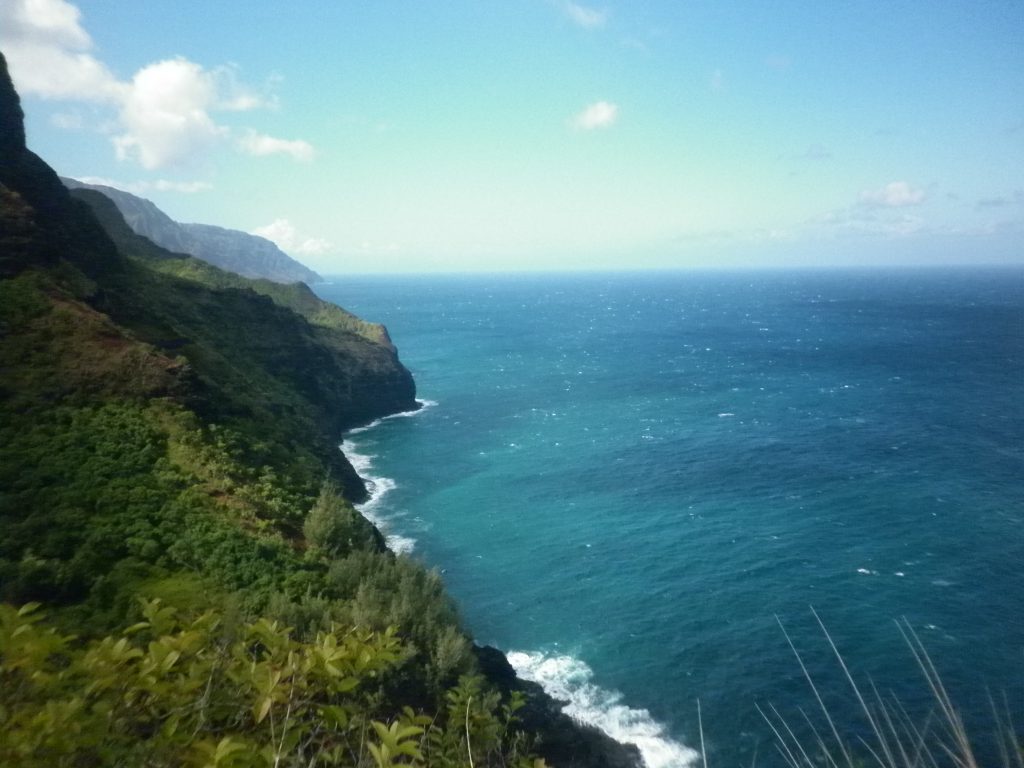
There were guava trees alongside the trail. I made sure to inspect each one and grab the ripe guavas off of the tree. How cool it was to hike through the woods and have trail food growing within arms-length!
Just before the 6-mile mark, we stopped at the river where we sat on rocks in the shade and filled up on water. Karine had bought a delicious mix of crackers and seaweed, called “arabe mix,” which we snacked on.
Nearby we came across a small shelter with a picnic table. We stopped for a moment and ate more food. I cut open a passion fruit and shared the other half with Karine. It had a sweet and tart taste. But what I remember most about this shelter was the graffiti written on the inside of the wall. I was mesmerized by the profound words of a poet, personifying the beach at Kalalau. The prose was simply beautiful. The fact that I had not yet been to Kalalau beach only added to the mystique of what was to come.
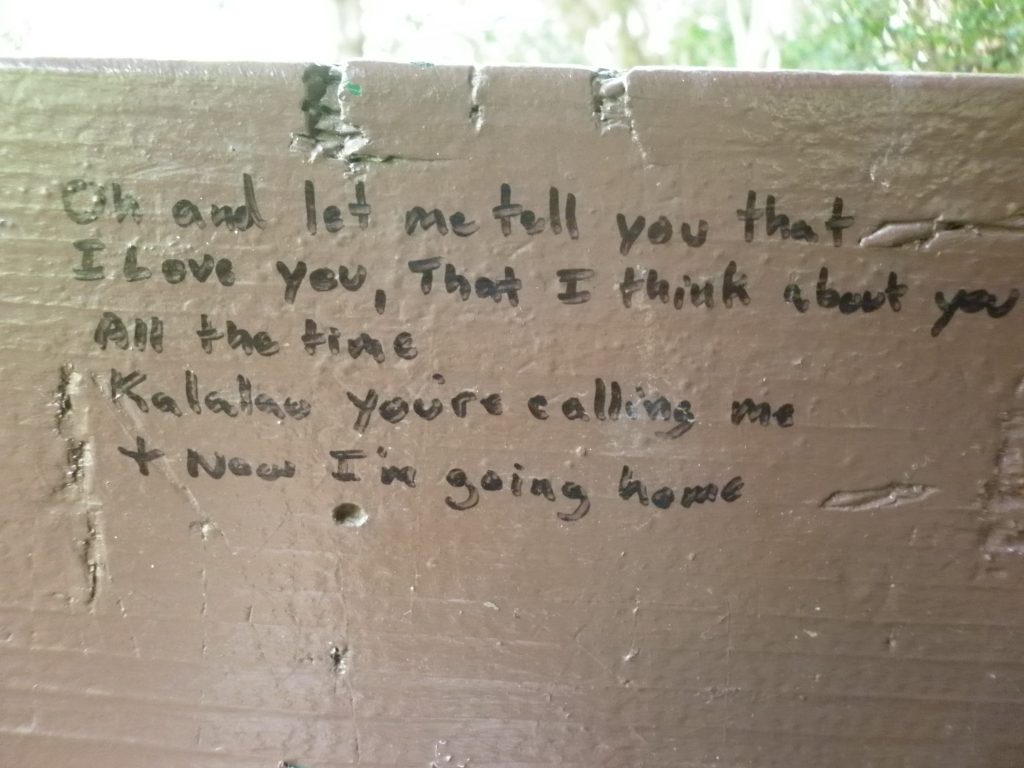
“Oh and let me tell you that/ I love you, that I think about you/ all the time/ Kalalau you’re calling me/ and now I’m going home.” – writer unknown
Someone had abandoned a sleeping bag at the shelter. Upon closer inspection, it looked brand new. I figured we could use it so I packed it up and carried it with me. As much as I like packing light and moving fast, I won’t deny that I also like to be insulated from the cold ground. The original plan was to rough it using a pair of jeans, a sweater and a space blanket, but that was subject to change – as all plans are.
Soon after the 6-mile mark, we lost the trail. We wandered a bit trying to find our way, until we randomly met up with Danielle, a German girl who had also stayed at the Honu’ea hostel in Kapa’a. She made the same mistake we did, but together, we finally found the trail. We probably lost about half an hour of daylight. My instinct was to hike a little bit faster to make up for lost time, but at the same time I didn’t want to hike so fast that I didn’t get to enjoy the hike or increase the risk of spraining an ankle. As I’ve learned over the years, “Don’t run when you can walk.”
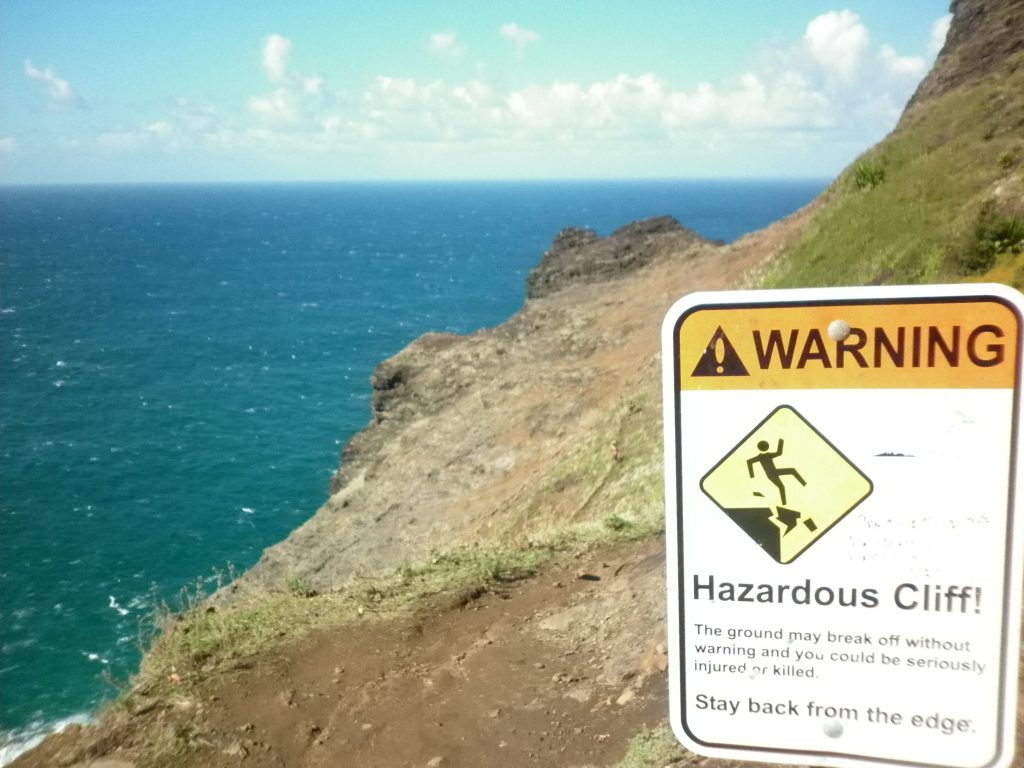
A few miles closer to Kalalau beach, the valleys became much smaller and the trail became a rocky path above a steep cliff. This was the most enjoyable part of the hike- it also contained what many consider to be the most dangerous, or scariest, part of the Kalalau trail. At one point, my backpack brushed up against a large rock, dislodging my new sleeping bag, which fell down a steep, rocky ravine. I didn’t know this was happening until a few seconds later when Karine got my attention. I watched as the sleeping bag fell… and fell… and continued to fall until it finally stopped against a small tree growing in the ravine. I thought to myself, “Well, that’s lost.” It was quite an eyesore from the trail above. I looked closer at the steep slopes lining the ravine and it looked like I could safely make my way along the bottom of it to rescue my sleeping bag.
I left my backpack with Karine and began my descent. The rocks beneath my feet felt stable and it wasn’t very long before I finally reached the sleeping bag. Triumphantly, I raised it above my head and showed Karine. I rushed back up to the trail where Karine was, packed up the sleeping bag, and we began our precarious walk on “Crawler’s ledge.”
Crawler’s ledge appears to be more dangerous than it really is because of the long drop to the ocean below and the exposure to very strong gusts of wind. For these very reasons, I absolutely LOVED it! Later, when I first saw the video of Karine and I crossing the ledge, I said, “Whoa, that’s scary.” Immediately afterwards in the video, it showed me with a big grin on my face saying, “It’s not that scary!” This was my favorite part of the trail. I can still feel the force of the wind and can hear the pounding of the surf below.
The trail continued along very steep mountain slopes and cliffs. It was beginning to get late in the afternoon and Karine and I were both visibly tired. Eventually we came to an area where the earth became red. A sign said that we were in the Kalalau Valley. We were almost there!
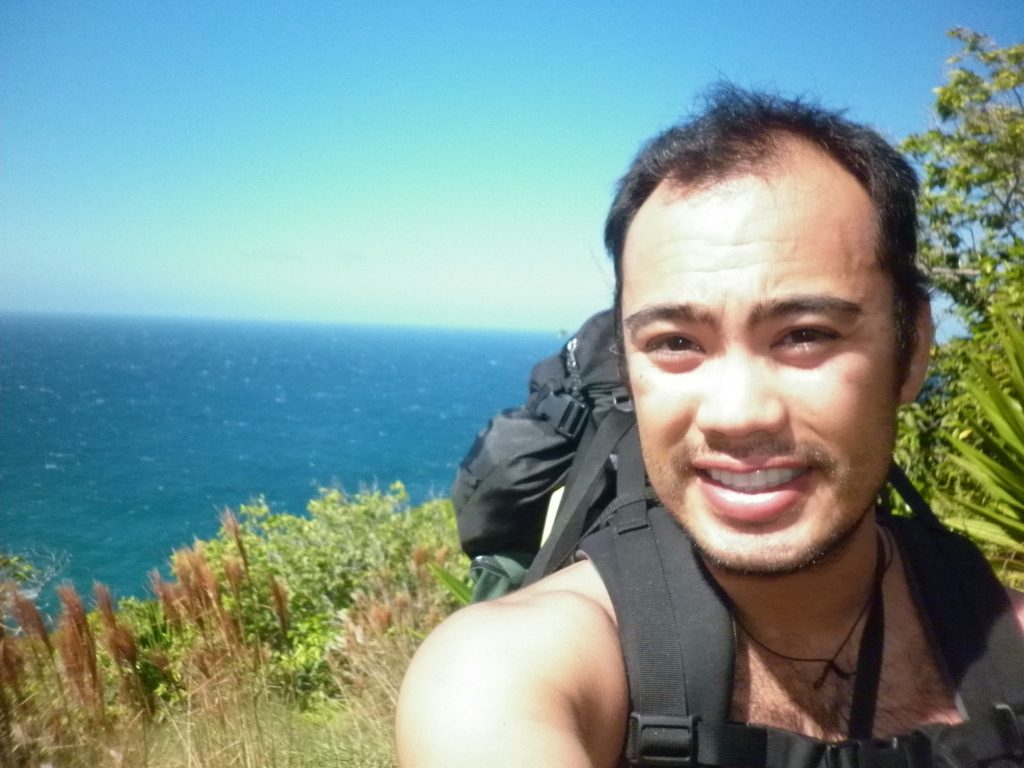
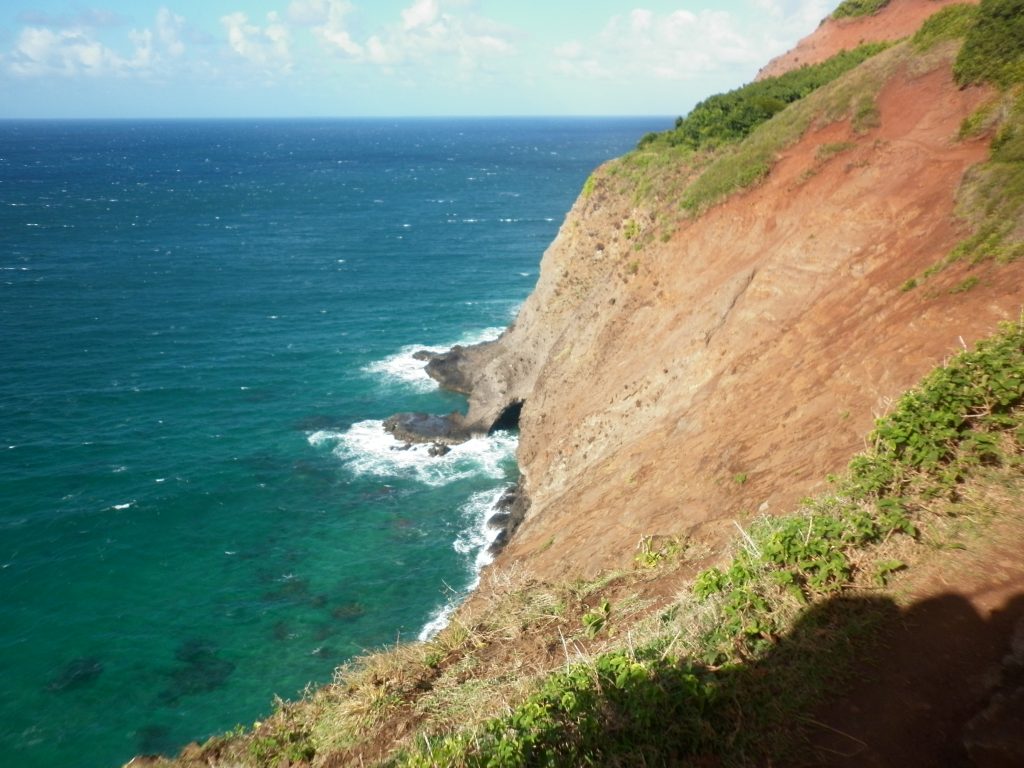
We descended the red hill to a treeline where we stopped to rest. We were exhausted at this point. I cut open the last passion fruit that I was carrying and shared the other half with Karine. We savored the juicy pulp, which boosted our morale tremendously. We made our way through a wooded area and passed a few campsites until we came to the Kalalau River. We topped off our water and then crossed the stream. Karine walked right through it, while I hopped precariously across on large rocks.
As we walked the last half mile to the campsite, a hippie girl with a buzzcut caught up to us. She introduced herself as Anna and said that she was meeting some of the other full-time campers for a potluck and a meditation session. She carried a salad, which she had picked from a local garden, and some passion fruit which she kindly gave to us. We walked with her to her friends who were all very friendly. They invited us to their meditation session, but we had to decline since it was getting late and we still needed to set up our camp.
We found a spot in the woods near the center of the beach. Karine set up the tent and tarp while I collected firewood. It didn’t take long before I had the fire going. I boiled water to add to the instant mash potatoes and beef jerky that we were having that night for dinner.
After dinner, we needed water for our camp so we set off in the dark to try to find a our water source, which we heard was only about a 15-minute walk away. We stumbled upon another camper who was headed in the same direction so we followed him there.
Our water source was a picturesque waterfall on the far end of Kalalau beach, where the beach meets a steep wall of rock. The full moon provided ample light to walk down to the base of the falls and collect water. After filling up our water bottles and washing our dishes, it was time for a bath.
I stripped down and went first. The water was very brisk, but it felt great to wash off two days’ worth of sweat and dirt. There was a plastic tube left behind so that people could place one end against the waterfall and direct water out of the other end more effectively on them. I used the same methods I’d employed all over the world when taking cold showers: wash extremities first, then torso, head last and remember to breath. I took a mental step outside of myself for a moment to see the surreal situation that I was in. There I was, bathing in a waterfall on a remote beach in Hawaii underneath a full moon.
Karine bathed next in her bathing suit. Then we went back to camp to put away our water and clean dishes.
We walked to the beach and hung out there for a little while. It was so bright out with the light of the full moon. The only other signs of life out there were the headlamps of a random person or two who’d be walking along the trail parallel to the beach and there were very few of them, adding to the feeling of remoteness and isolation. Thank goodness Karine was there, otherwise, I wouldn’t have anyone to talk to and to say, “Look around! Isn’t this cool!?”
November 10, 2011. Exploring the Kalalau Valley
I woke up before Karine and started collecting firewood. Once Karine woke up, I boiled water for our brown sugar and maple syrup-flavored oatmeal. Neither of us normally like oatmeal, but the oatmeal packets I served up hit the spot. I had two packets while Karine had only wanted one. To supplement breakfast, I had a few handfuls of ranch Wheat Thins and some beef jerky.
We went to the beach after breakfast and walked to the far end past the waterfall. We encountered a large sea cave, one of which had a couple of sea kayaks, a few mice scurrying about, and a camp inside it. We explored the cave and talked to its inhabitants, Robert and Chris, and learned a little bit about their lifestyle.
Chris is a professional beach bum. He does odd jobs in Kauai when he needs money and then lives at Kalalau beach until the money runs out. It’s not a bad life that he lives either. He catches fish right out of the surf, hangs out with his friends, and soaks in the beauty that is Kalalau beach.
We walked as far as we possibly could down the beach until it met an impassable sea cliff at the ocean and we could walk no further. There was another sea cave which we explored. The entrance was littered with fallen rocks, which we were warned by the locals to beware of. Karine and I stepped around the rocks as best as we could and quickly walked through the debris field. All it would’ve taken was one strong gust of wind, one large falling rock and it would’ve been game over for either of us.
This one dripped water from the ceiling and the floor was damp. Aside from that, there wasn’t much to it.
Leaving the cave, we walked back to our camp. There was an industrial-grade, plastic bag that littered the beach. Our consciences made us pick it up and carry it with us back to camp to preserve the beaches pristine appearance.
Once at camp, I restoked the fire and boiled water for our lunch. This was no easy task. It took several attempts at balancing the pot on rocks that lined the fire ring, on hot coals, or what eventually became the best way to do it – the rock-stick-pot-fire method.
The boiled water was for our ramen noodle lunch. I like to boil most of the water off leaving the noodles soft and salty. Karine likes hers ramen noodles raw and crunchy.
After lunch, I left Karine to forage for fruit in the Kalalau Valley. Karine stayed behind in camp and hung out at the beach while I went exploring. I carried a light gym bag, a bottle of water, a knife and a granola bar.
Going into the woods is so much fun for me. As a child, I built forts, climbed trees, and crafted bows and arrows in the woods behind my neighborhood. Being in the woods takes me back to those days. I always loved exploring in the woods and my attitude towards walking off alone into the Kalalau Valley was no different.
I met a local by the name of “Uncle T” on the way out. I asked him about all of the edible plants that could be found in the forest. Armed with local knowledge, I was able to find passion fruit trees on the bluff near the entrance to Kalalau beach. I picked the ripe ones right off the ground. Every once in a while, I’d cut one in half and suck the seeds and pulp out. The rest I saved for Karine and myself. I envisioned myself returning to camp and proudly showing off my bounty of fresh fruits to Karine – perhaps an instinctual vestige from our ancestral days when men hunted and gathered for their survival and the survival of their families. I would’ve roamed the forest for miles before returning back to camp empty-handed. This was a mission in which I could not fail.
I wandered into a camp inhabited by some long-term campers, more hippie-types. I sat with them and chatted for awhile. Their camp was known as the “Sanctuary,” a safe place for “wild” humans. It was also known as a “community kitchen,” where anyone could just drop in if they needed anything, like a cup of sugar, extra camping fuel, etc. Like everyone else that Karine and I met on the Kalalau trail, these people were incredibly warm and hospitable. I was invited to come by anytime to hang out. I was very much impressed by their choice of lifestyle- a subsistence living in a veritable Garden of Eden.
Onward, I trekked deep into the Kalalau Valley, along a path known as “hippie highway” and moving along the banks of the Kalalau River. I was on the lookout for guava, oranges, passion fruit, mango, banana and anything else edible. It wasn’t easy. The trees were difficult to find and, of the ones that I did find, they were nearly picked clean of ripe fruit.
Walking off the beaten path, I discovered hidden camps, a maze in a bamboo forest, but not too many fruit trees. I rummaged through the supplies of one abandoned camp, but took nothing since the food was at least 2 years old according to the expiration dates on some of the dry goods. Fortunately, Karine and I weren’t desperate or hungry. I did take a mental note on the camp’s location, just in case.
The only fruit I took out of the Kalalau Valley were a couple of oranges. I climbed very high into the tree and shook it forcefully to get the ripe oranges, just as Uncle T told me to do. Though the pickings were slim, I was happy to know that I wasn’t going to return to camp empty-handed.
On the way back, I met Red, one of the locals. He showed me the location of wild mint and ginger plants growing near the river. I was happy to acquire this knowledge. It felt like living in Zambia, where I learned to live like Zambian villagers in the bush. I took a few leaves from the mint and cut some ginger root to make tea later on. I also ate a ginger flower. Sure enough, it tasted like ginger.
Back at the camp, I showed Karine the fruit I had gathered out of the valley – minus one orange, which I had to eat to stave off hunger. I like to think she was impressed.
Since it was already late in the afternoon, I started the campfire and started boiling water again for dinner. We ate and then hung out at the beach before going to sleep.
November 11, 2011. A day at the most beautiful beach in the world!
The day began with a healthy dose of oatmeal for breakfast, followed by a trip to the waterfall to shower, wash dishes and refill our water bottles. We spent the rest of the day around camp and on the beach.
 Since it was the winter season, the trade winds were blowing, which created heavy surf on the beach. Thus, we weren’t able to go swimming or diving for shellfish and lobster as planned. Instead, Karine and I grabbed our books, cameras, water bottles and her beach blanket and headed out to the beach. It was windy and sand was blown all over us. I took cover underneath the blanket while Karine played in the sand.
Since it was the winter season, the trade winds were blowing, which created heavy surf on the beach. Thus, we weren’t able to go swimming or diving for shellfish and lobster as planned. Instead, Karine and I grabbed our books, cameras, water bottles and her beach blanket and headed out to the beach. It was windy and sand was blown all over us. I took cover underneath the blanket while Karine played in the sand.

Cruise ship. If given the choice between a fancy, cruise ship and camping on Kalalau beach, I’d choose Kalalau beach 10 times out of 10. Kalalau is magic. Kalalau is surreal. Kalalau has soul.
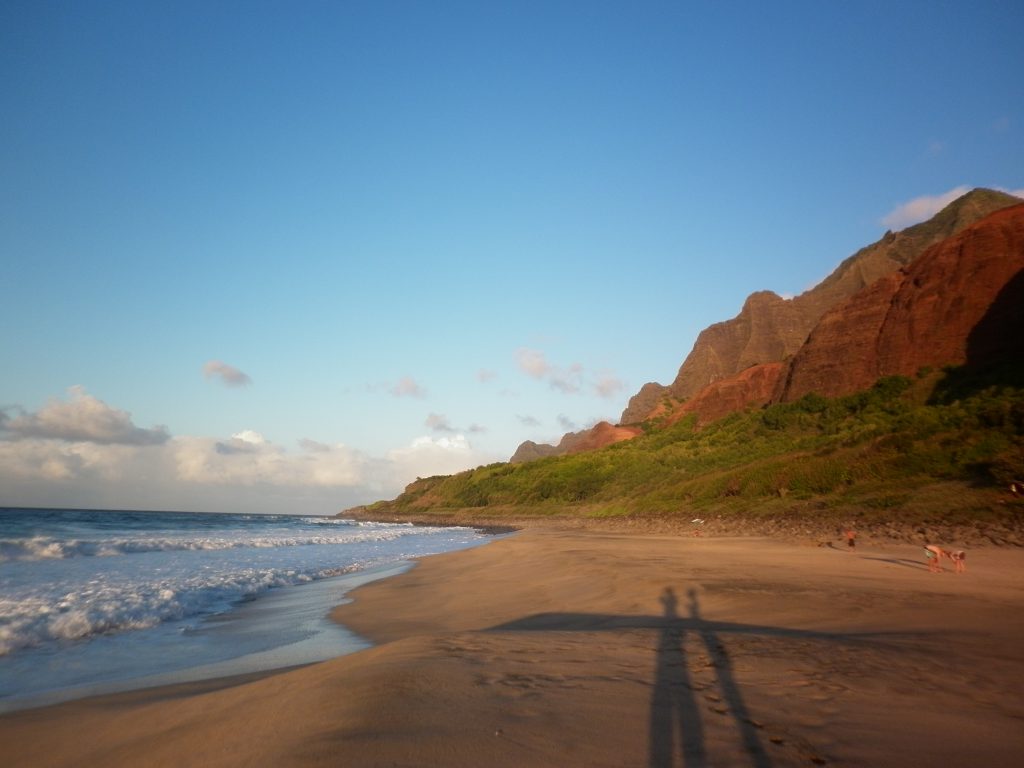
Here we have a nice combination between a beach vacation and mountain vacation. We have the best of both!
I left right after sunset to get the fire going again to make dinner. We had Knorr’s creamy garlic shells for dinner. I placed the pan on top of hot coals to avoid the risk of spilling water and food. In a little over half an hour, dinner was served. We had Macadamia nut cookies that Autumn from the Honu’ea hostel gave us before we left. I savored every bite.

What Karine doesn’t know is that she is about to partake in the best Knorr’s creamy garlic shells that she will ever have in her entire life. We later had Macadamia nut cookies and those were the best I’ve ever had!
It’s remarkable the extent to which our circumstances have an impact on our perception of the world. Kalalau beach has that effect on people. The aloha spirit is indeed palpable all over Kauai island. There is an ambiance that radiates peace and love for others and for nature. As a stranger to the island, I initially shrugged it off as local psychobabble, but as I became more acquainted with the island, I totally bought into it.
After dinner, we gathered our sleeping bag and beach blanket and headed out to the beach. The plan was to meet up with some of the locals and other campers who were going to light bonfires that night.
Once we got to the beach, we met Uncle T. He was telling us about sea turtle eggs that were due to hatch. He was waking up at 4 in the morning every night waiting for the eggs to hatch. I was motivated to join him, except I had neither an alarm clock nor a watch. He thought for sure that tonight would be the night the baby sea turtles would hatch out of their shells and march into the sea.
Since none of the bonfires were lit, Karine and I just laid on the beach, taking in all the beauty around us. Everything around us slowly lit up in a pale light as the full moon rose. I could see the jagged peaks of the mountains behind us. Only the brightest stars could be seen in the sky. We could see the white outlines of every wave that neared shore. We could see up and down the length of the beach. It was like daytime.
Karine fell fast asleep. I laid next to her, incredulous at everything she and I had seen and done since we started the hike. The mystique of Kalalau beach had revealed itself to us. I could now empathize with what that poet had written on the cooking shelter back at mile 6 on the trail. Oh and let me tell you that I love you, that I think about you all the time. Kalalau, you’re calling me and now I’m going home. I, too, had fallen head-over-heels in love with this place. And how could I resist? The beauty was intoxicating.
I walked to one of the bonfires once it was lit, but I didn’t stay long. I made the excuse that I wanted to go check on Karine and promptly left. Once I returned to Karine, we packed up our sleeping bag and beach blanket and called it a night.
November 12, 2011. Moving on.
Karine and I were up early in the morning. While she packed up the tent and tarp and refilled our water bottles at the waterfall, I gathered firewood, lit the fire, boiled water, and served us oatmeal for breakfast. I don’t normally eat oatmeal – in fact, I detest it! In this case however, I savored every flavorful bite. Perhaps it was the ambiance from being in the most beautiful beach in the world that enhanced my sense of taste, or maybe I was just hungry. I licked my plate clean. I would’ve licked Karine’s plate, too, but civility prevailed.
We left Kalalau beach in the morning shade of the mountain towering above us. The trail took us past the camping area, down to the Kalalau River, up onto the bluff and then onto the red hill that overlooks the beach. We stopped to take our last look behind us at the lonely beach that had captured our hearts. So long, Kalalau beach, and thanks for the memories!
We continued past the hill and along the same spectacular part of the trail that we had walked days before. I wanted to walk more slowly to make it last longer. Conditions were less windy and there wasn’t any threat of rain like before. I took pictures until my camera battery died and then relied on Karine to take photos for the rest of the trail.
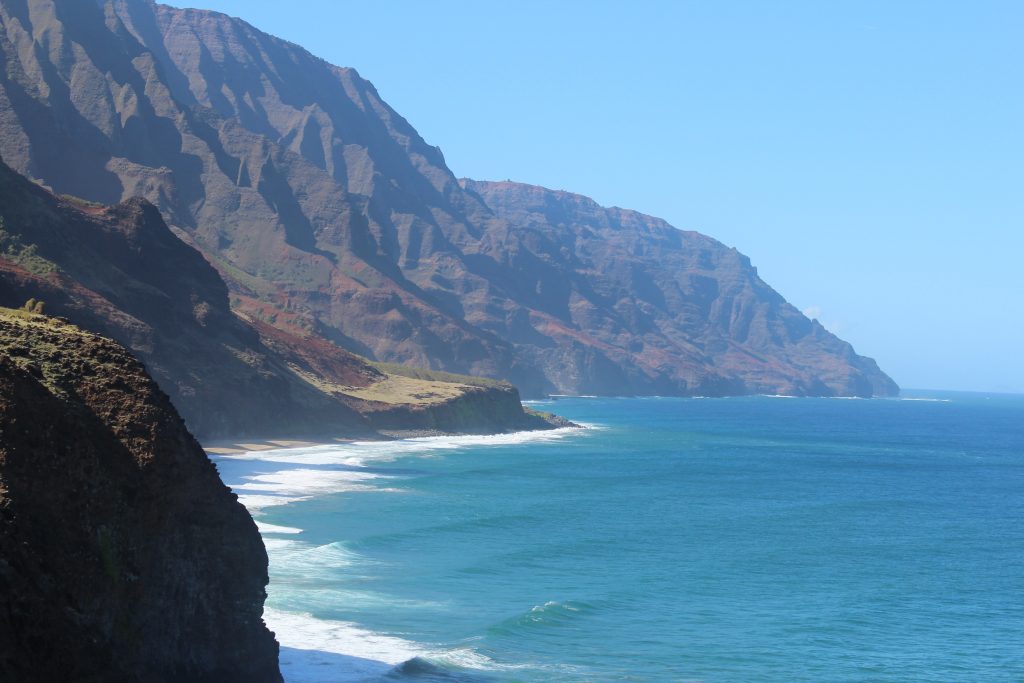

The trail is as wide as the length of Karine’s foot and that slope she is standing next to is very steep! One misstep and you’re done!
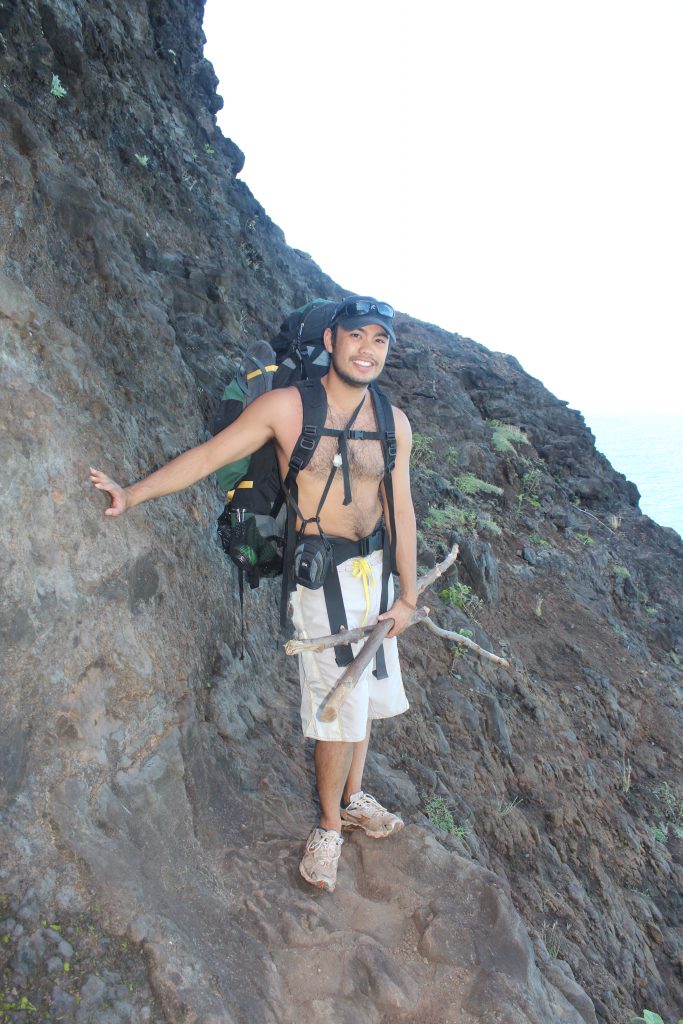
Without the wind, we didn’t have to worry about getting blown off the rocks and pulverized by the surf down below.
We stopped at the picnic shelter at mile 6 for lunch. I ate light snacks while Karine ate a pack of raw ramen noodles. I thought that was weird until I tried it. It was pretty good!
I took a moment to read all the graffiti in the shelter once again, mesmerized by its profound character.
From the lunch shelter it was four more miles to Hanakapi’ai beach. We took more pictures along the way, but still managed to move faster than when we first walked the trail.
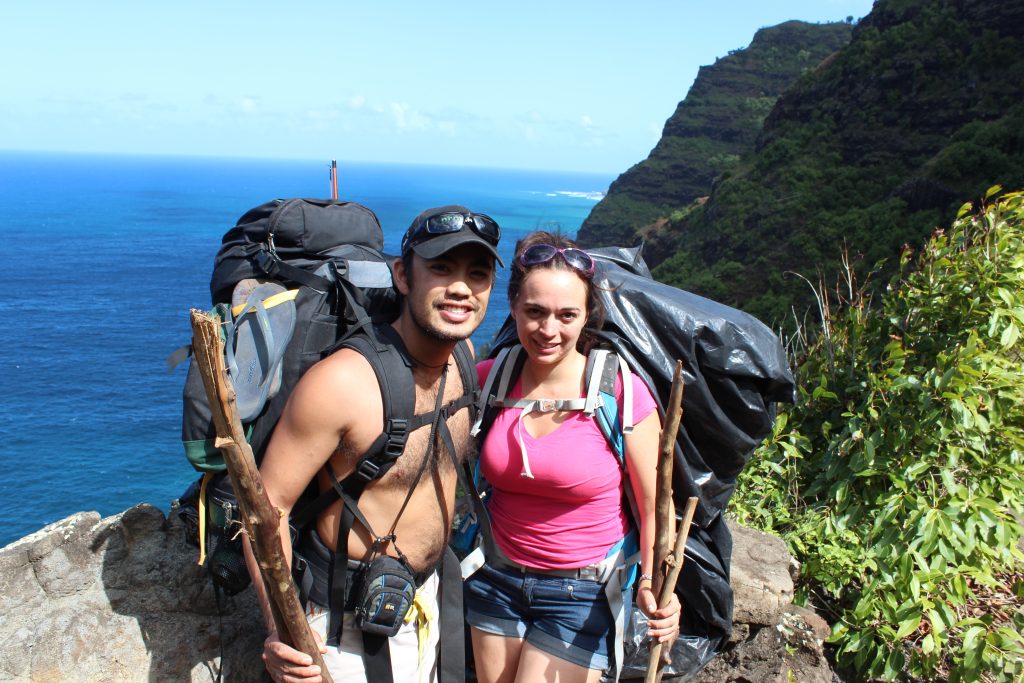
We seemed to walk for a very long time. I had neither a watch nor a topographic map, and I wasn’t keeping a pace count so I kept wondering when we’d reach Hanakapi’ai beach. I asked all the hikers walking in the opposite direction where they were coming from and how long they’d been walking in order to get my bearings.
Karine and I talked about how nice it would be to sleep in a warm bed and have a real meal in town. Hanakapi’ai was only 2 miles from the trailhead and civilization. We planned to wait and see how we felt once we arrived at Hanakapi’ai beach before making the decision to either stay one more night at the beach or head back to Kapa’a.
Eventually, we saw the beach below us. It was only about 3 pm in the day and the beach was full of day-hikers. It did not appeal to me in the slightest. Part of the allure behind this trail lay in the perception of being far removed from the rest of the world. We decided to hike the rest of the way to trailhead at Ke’e beach.
We crossed the Hanakapi’ai river and hiked up a long hill. The ground was a lot less muddy than before and it was covered in a carpet of ants. We didn’t stop that much, lest the ants crawl up onto our shoes and bodies.
We saw many day-hikers on this part of the trail, which is the most highly-trafficked part and, therefore, much wider than the rest of the trail. It was easy hiking. One woman admired that Karine had carried a large, heavy backpack all the way to the end of the trail and back.
As we neared the trailhead, we saw a parking lot with cars through an opening in the trees. I told Karine it was nice to see civilization again. Inside, I was a little sad that our Kalalau adventure was coming to an end.
Once we arrived to the end, I moved to hug her in gratitude for everything and she went straight for a kiss! I wasn’t expecting it so that was a very pleasant surprise.
We left our walking sticks for others to use against the wooden sign, exactly where we found them when we first started our hike. Their value to the safe completion of our hike was immeasurable and cannot be overstated. Like when I had to ditch my old boots in the Patagonia, the same boots that have seen more of the world than most Americans, I was sad to leave those walking sticks behind. Nonetheless, it was an unceremonious act.
The next order of business was to find a ride back to Kapa’a. We walked past the parking lot for about 20 minutes before we were picked up by a guy in pick-up truck. He only took us as far as Hanalei. From there, a guy from New Jersey and a Swedish girl brought us to the bus stop at Princeville.
It was close to sunset when we arrived at Princeville. I knew it was important to get a ride soon because our odds of finding one would significantly worsen at night. Since Karine had the advantage of being female and much better looking than I, which definitely helps in getting free rides, I left her with the responsibility of sticking out her thumb alongside the road. I only had enough time to toss the trash in my backpack into the garbage can next to the bus stop when, moments later, a woman picked us up in her car and drove us all the way to our hostel in Kapa’a! Everything always works out!
Karine and I took hot showers, went out for dinner, and got to sleep in comfortable dorm beds that night. It was a welcome change from sleeping in the bush. The next day, Karine left the hostel to camp at the northern beaches for a few days on her own. It wouldn’t be the last time that I saw her.
“Once you have traveled, the voyage never ends, but is played out over and over again in the quiestest chambers. The mind can never break off from the journey.” – Pat Conroy

